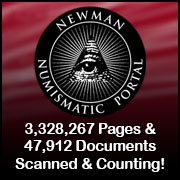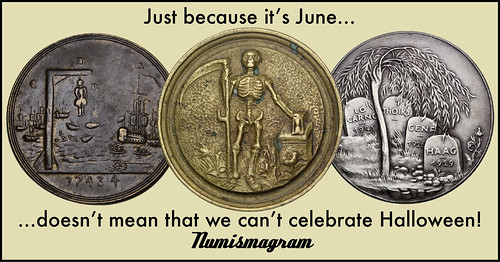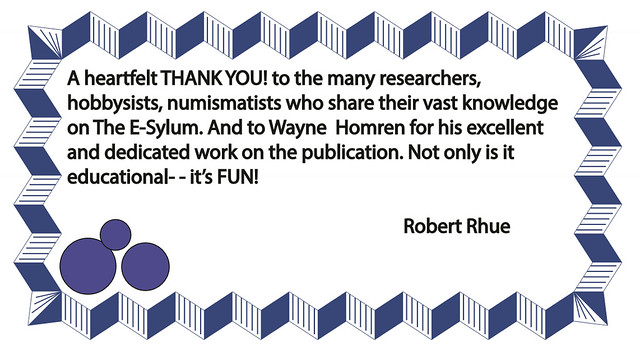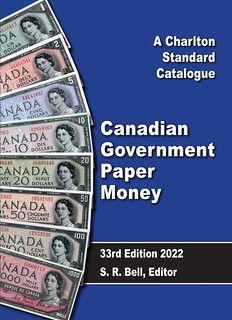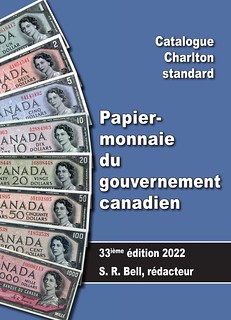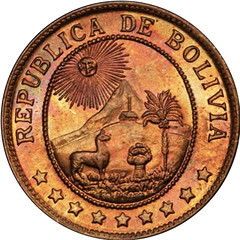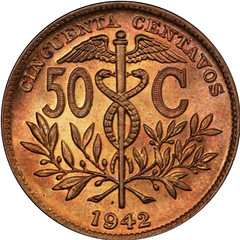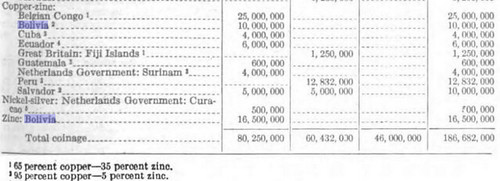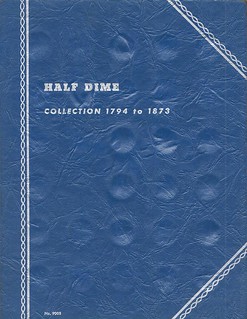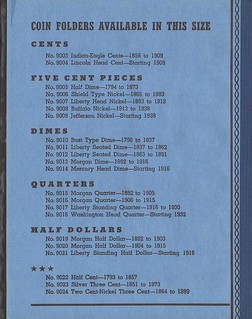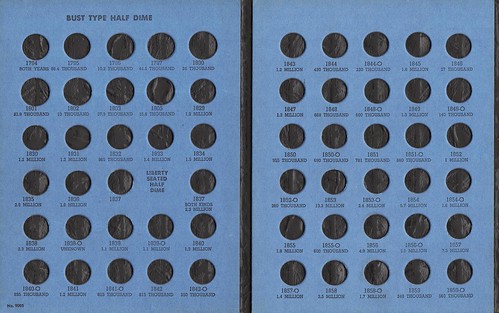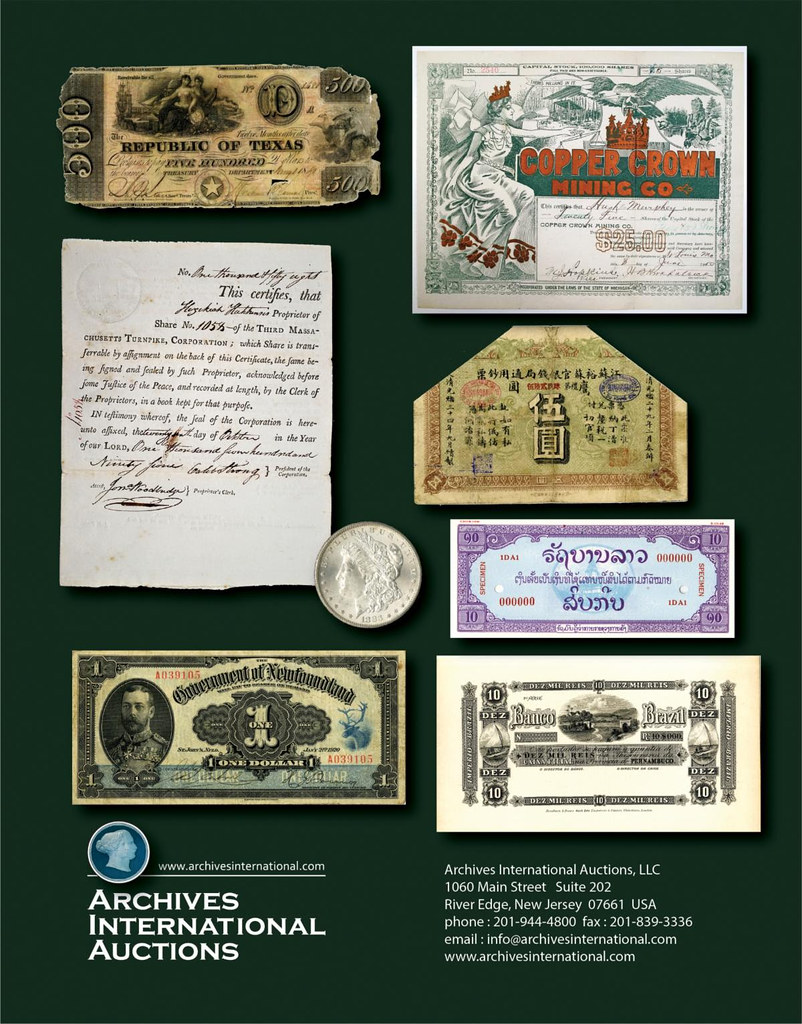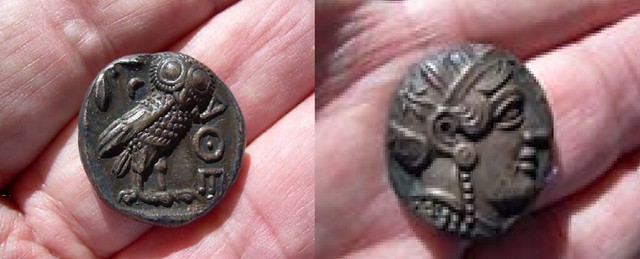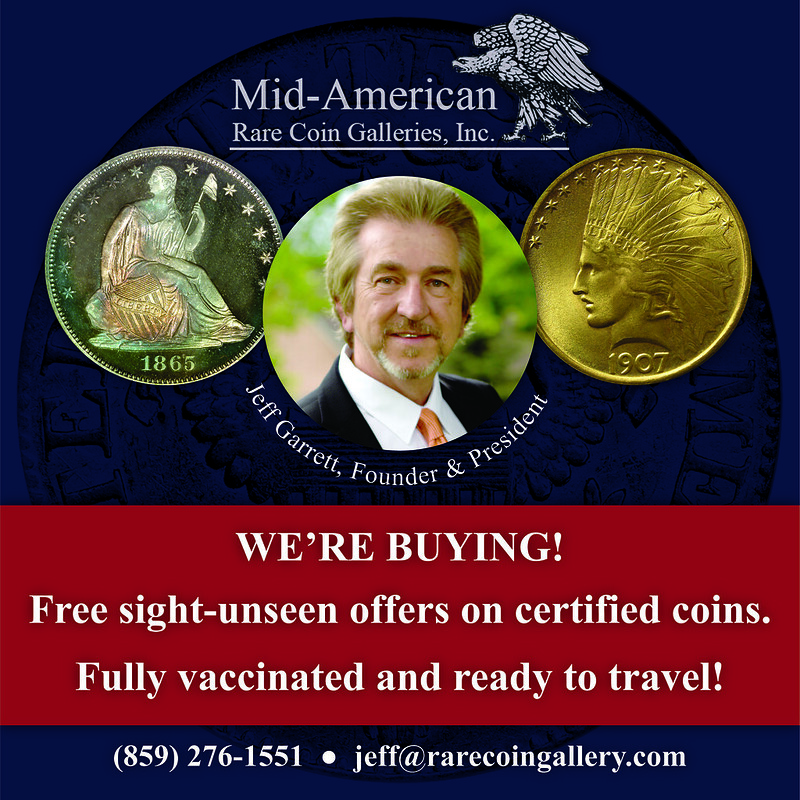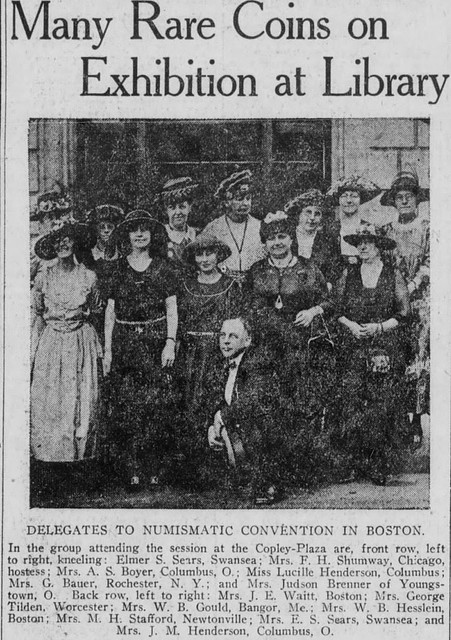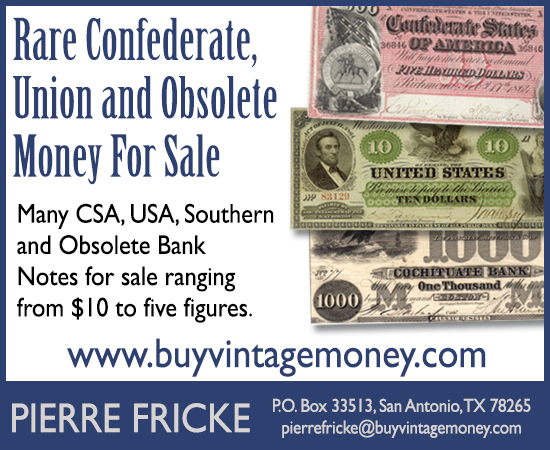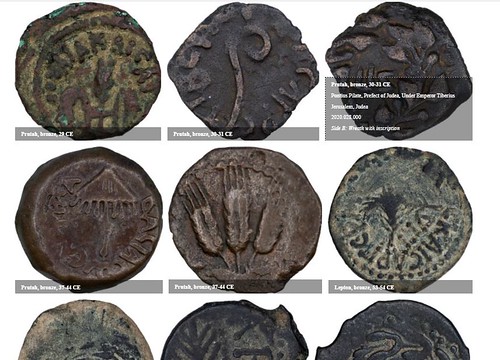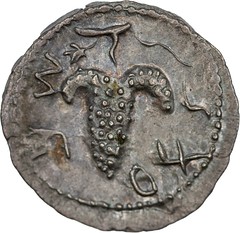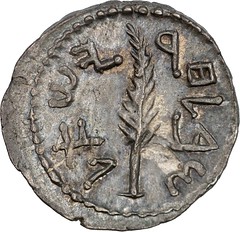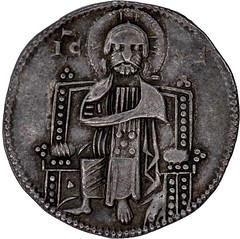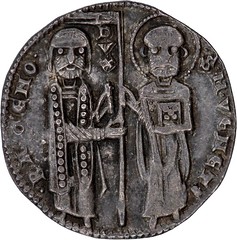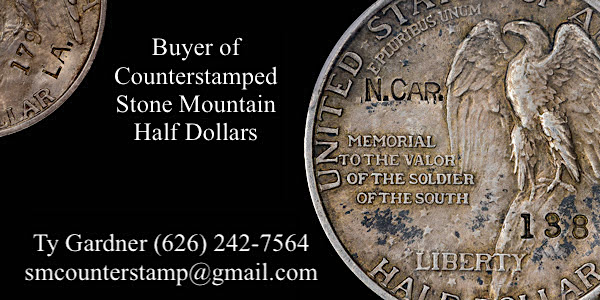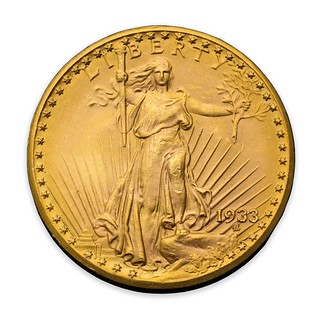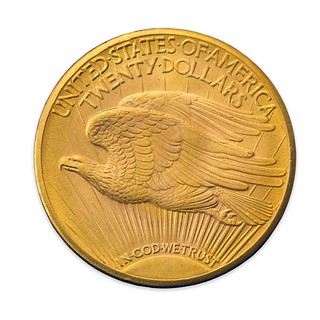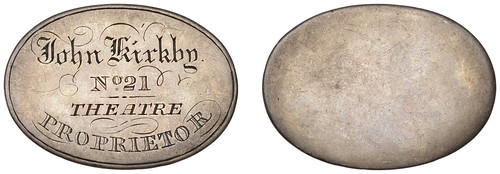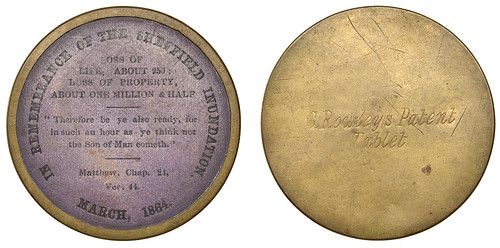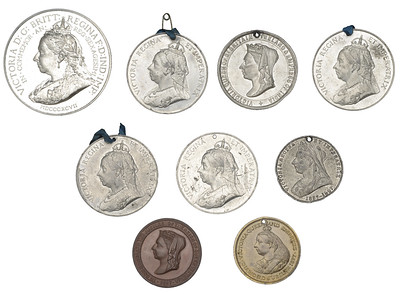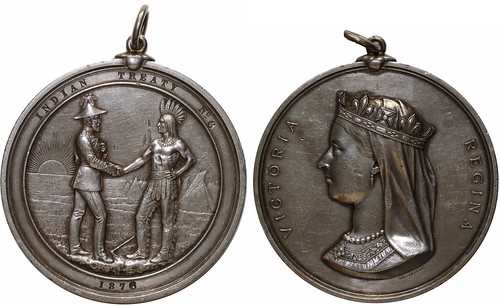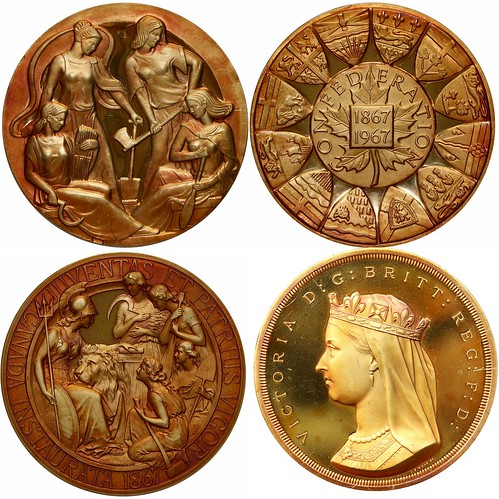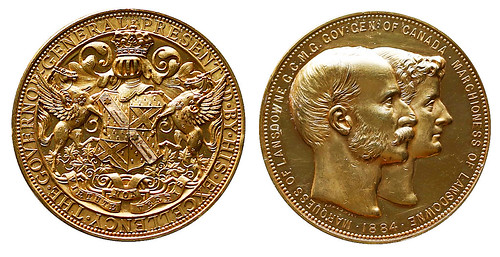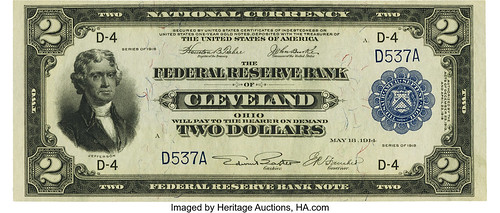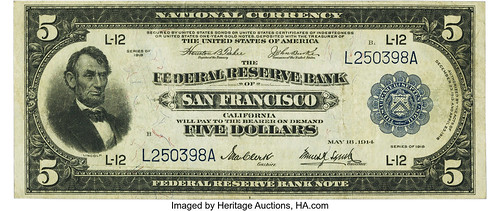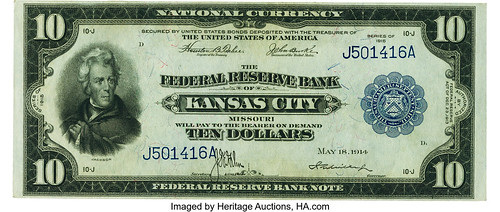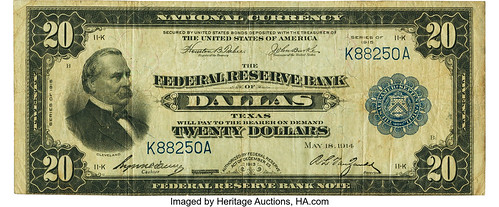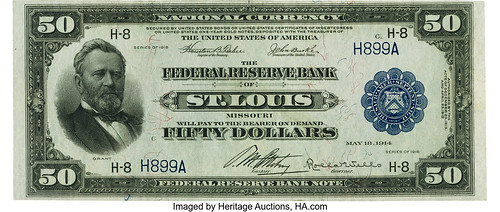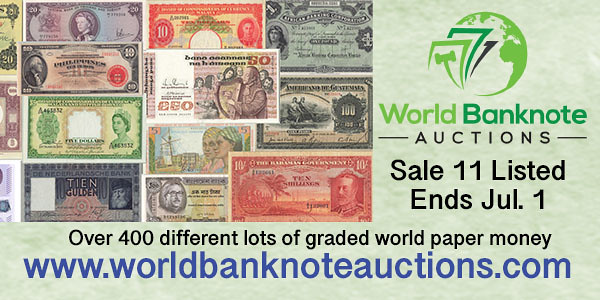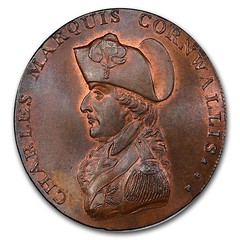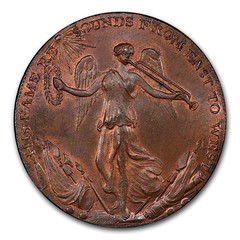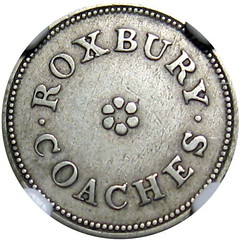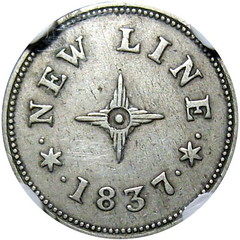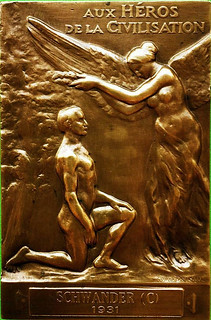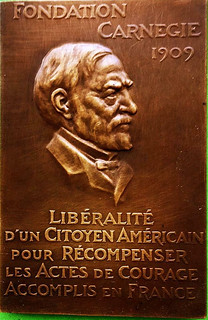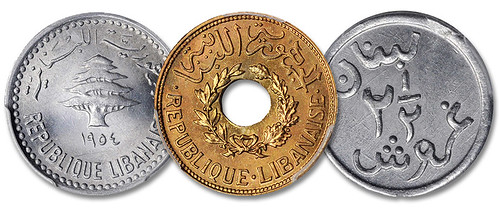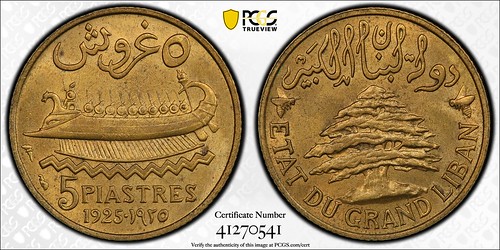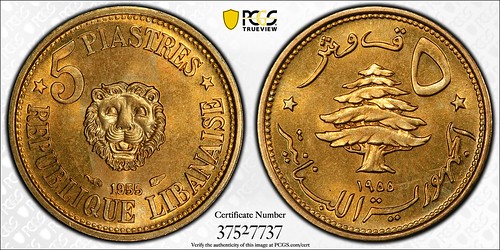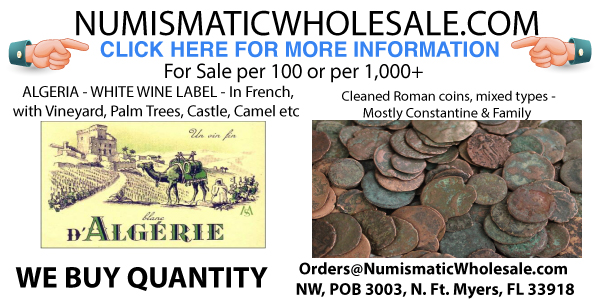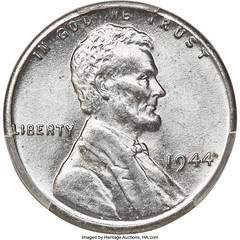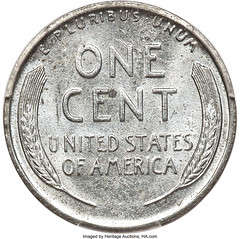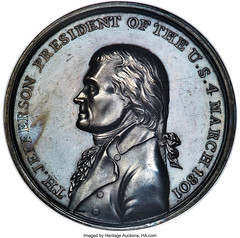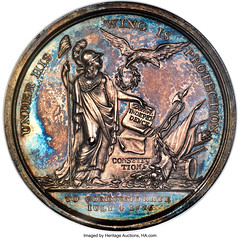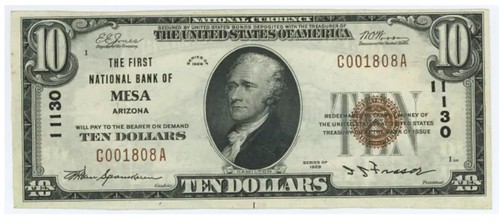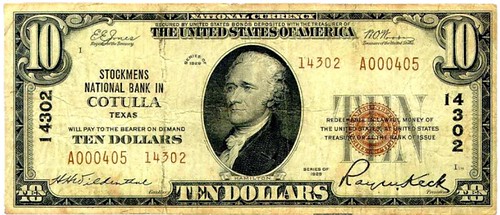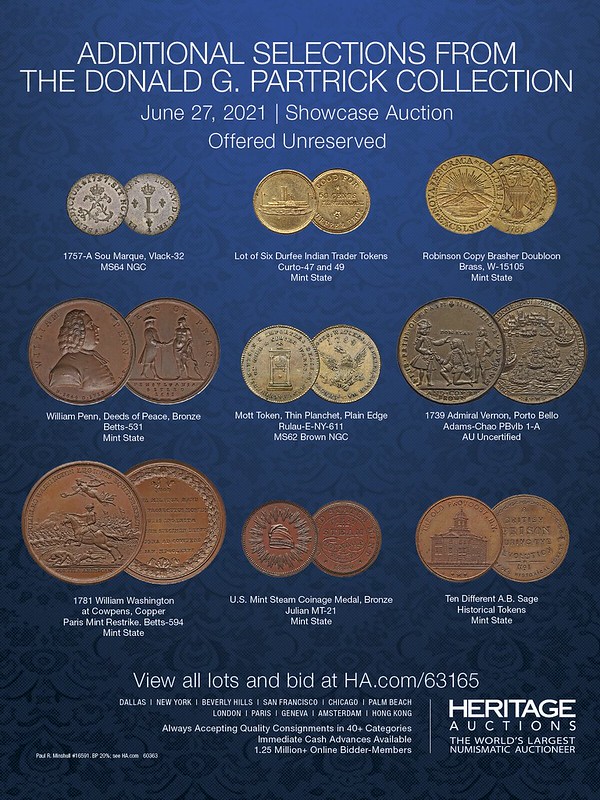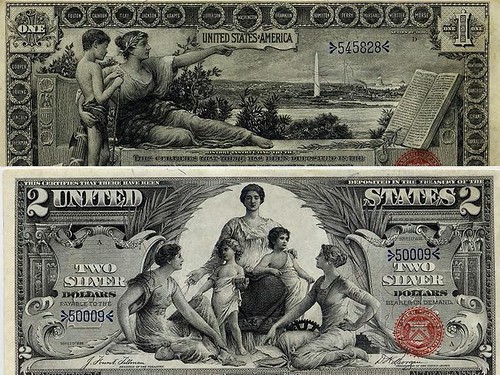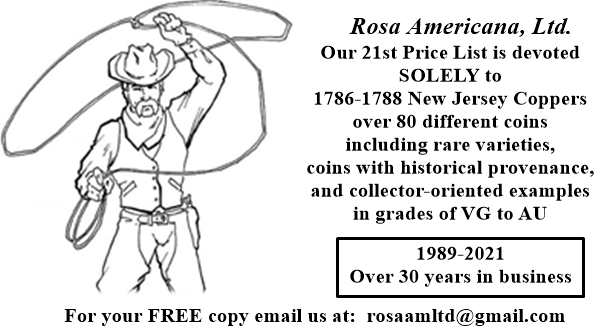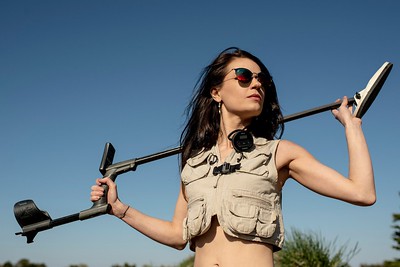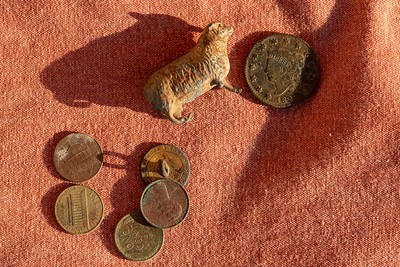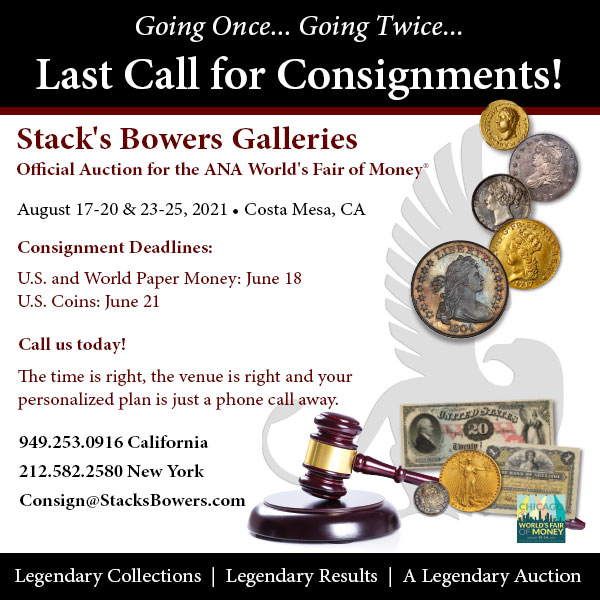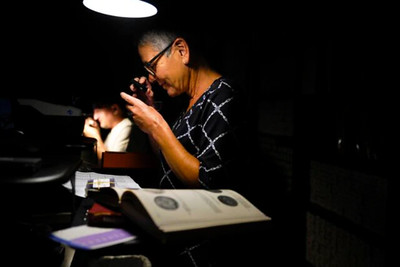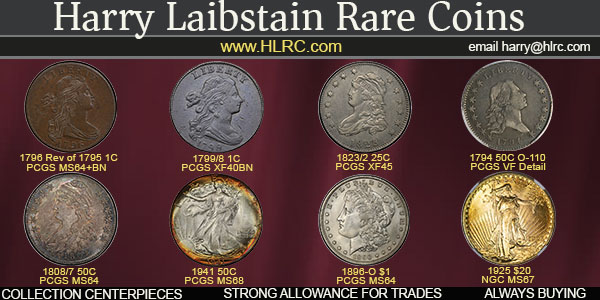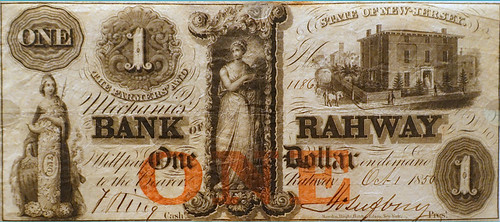
Visit our NBS Sponsors


About UsThe Numismatic Bibliomania Society is a non-profit association devoted to the study and enjoyment of numismatic literature. For more information please see our web site at coinbooks.org SubscriptionsThose wishing to become new E-Sylum subscribers (or wishing to Unsubscribe) can go to the following web page link MembershipThere is a membership application available on the web site Membership Application To join, print the application and return it with your check to the address printed on the application. Print/Digital membership is $40 to addresses in the U.S., and $60 elsewhere. A digital-only membership is available for $25. For those without web access, write to: Charles Heck, Treasurer AsylumFor Asylum mailing address changes and other membership questions, contact Chuck at this email address: treasurer@coinbooks.org SubmissionsTo submit items for publication in The E-Sylum, write to the Editor at this address: whomren@gmail.com BUY THE BOOK BEFORE THE COINSale CalendarWatch here for updates! |
- WAYNE'S WORDS: THE E-SYLUM JUNE 13, 2021
- NEW BOOK: FADS, FAKES & FOIBLES
- NEW BOOK: WEALTH OF THE SOUTH TOKENS
- NEW BOOK: STREATOR'S TRADE TOKENS
- NEW BOOK: STRIKE IT RICH WITH POCKET CHANGE, 5TH ED.
- NEW BOOK: 2022 CANADIAN GOVERNMENT PAPER
- NEW BOOK: MODERN CHINESE PAPER MONEY 2021
- NEWMAN PORTAL: U.S. MINT'S BOLIVIAN COINS
- VIDEO: DENVER COIN EXPO 2021
- FIRST EDITION WHITMAN HALF DIME FOLDER
- ROBERT BURNHAM AND COIN COLLECTING
- VOCABULARY TERM: EDGE LETTERING, PART 5
- 1921 BOSTON ANA PHOTO INCLUDES ELMER SEARS
- EXHIBIT: TREASURE OF CHIANTI
- VIRTUAL EXHIBITION: COINS OF JESUS
- FAROUK 1933 DOUBLE EAGLE BRINGS $18.9 MILLION
- THE FAROUK 1933 DOUBLE EAGLE, PART 3
- DNW SHEFFIELD TOKENS AND BADGES
- THE MAX BRAIL CANADIAN MEDAL COLLECTION
- MORE COLTRANE COLLECTION PART 2 SELECTIONS
- NUMISMATIC NUGGETS: JUNE 13, 2021
- THE EARLY COINAGE OF LEBANON
- 1944 STEEL CENT OFFERED
- BRITISH VIRGIN ISLANDS MORGAN-PEACE DESIGN
- 1801 THOMAS JEFFERSON SILVER INAUGURAL MEDAL
- PLATES USED TO OVERPRINT 1929 NATIONALS
- MONEY DESIGNS AND SOCIAL MOVEMENTS
- PHILIPPINE CENTENNIAL COMMEMORATIVE NOTE
- THE NEW DETECTORISTS
- CERTIFIED COLLECTIBLES GROUP HIGHLIGHTED
- LOOSE CHANGE: JUNE 13, 2021
Click here to read the thin version on the web
Click here to subscribe
Click here to access the complete archive
To comment or submit articles, reply to whomren@gmail.com
Content presented in The E-Sylum is not necessarily researched or independently fact-checked, and views expressed do not necessarily represent those of the Numismatic Bibliomania Society.
WAYNE'S WORDS: THE E-SYLUM JUNE 13, 2021
 New subscribers this week include:
Pete Kane.
Welcome aboard! We now have 6,635 subscribers.
New subscribers this week include:
Pete Kane.
Welcome aboard! We now have 6,635 subscribers.
Thank you for reading The E-Sylum. If you enjoy it, please send me the email addresses of friends you think may enjoy it as well and I'll send them a subscription. Contact me at whomren@gmail.com anytime regarding your subscription, or questions, comments or suggestions about our content.
This week we open with six new books, updates from the Newman Numismatic Portal, a rare Half Dime folder, and more.
Other topics this week include Wealth of the South tokens, Canadian paper money, the Denver Coin Expo, the 1921 Boston ANA, edge lettering, the coins of Jesus, the Farouk 1933 Double Eagle, the 1944 steel cent, auction previews, and metal detecting.
To learn more about international coinage proposals, goloid and metric patterns, modern Chinese paper money, the U.S. Mint's Bolivian coins, the Treasure of Chianti, Izzy Switt, Sheffield tokens, Canadian Confederation Centennial medals, the early coinage of Lebanon, the 1801 silver Thomas Jefferson Inaugural Medal, and the Federal Reserve's digital dollar plans, read on. Have a great week, everyone!
Wayne Homren
Editor, The E-Sylum
NEW BOOK: FADS, FAKES & FOIBLES
The latest book by Roger W. Burdette covers a fascinating niche of American numismatics including the Barclay Mint Experiments, the Bickford Eagle, International Coinage, Goloid & Metric Patterns, Cometallic Money and more. Here's the press release. -Editor
Seneca Mill Press LLC proudly announces release of the latest numismatic book by Roger W. Burdette:
Fads, Fakes & Foibles.
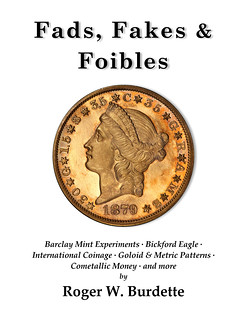 Most nineteenth century Americans thought of coins and currency in two practical
ways: a concern that their pieces of coin or paper currency would be accepted by
merchants for purchases and a desire to have more.
Most nineteenth century Americans thought of coins and currency in two practical
ways: a concern that their pieces of coin or paper currency would be accepted by
merchants for purchases and a desire to have more.
For those few involved in economic policy and politics, other, more esoteric aspects of coinage were of concern. Their three principal subjects were prevention of adulteration or counterfeiting, direct equivalence of international gold coins, and use of metric weights for coins. Underlying each of these were certain economic assumptions and profit opportunities that pushed governments toward decisions.
Adulteration and counterfeiting were of concern to all because bad coins meant that merchants and banks would reject the money a person offered in payment. In this regard, it must be remembered that gold coins were simply convenient tokens containing a certain weight of pure gold. Banks and merchants could, and occasionally did, reject legitimate gold coins because they appeared heavily worn or were lighter than official standards. This was the focus of James T. Barclay and his obsession with preventing degradation of the national coinage.
Nickel mining maven Joseph Wharton went to great lengths to promote alloys of nickel and copper for minor coins valued up to ten cents. Here, he cracked skulls with persistent mint officers who thought of base metal coins only as temporary Civil War substitutes for silver dimes and half dimes.
Businessman Dana Bickford, alternatively, was concerned with the ability of travelers to easily know the value of their American money in certain European currencies. His idea for a gold international coin was not intended as a standard of value, but as an equivalency calculator. His changes were of design, not content although much of the work was facilitated by George Dunning, former Superintendent of the New York Assay Office.
Silver producers of the 1870s wanted to stop the decline in silver value compared to gold. Others wanted a bimetallic standard so that gold and silver would circulate equally. Backers of standard international coinage wanted to follow principles of the Latin Monetary Union and have the gold coins of all major nations exactly equal one another. Further, many idealists across the world wanted all coin weights expressed in grams of pure gold or silver and coin diameters and weights to be whole numbers. Here we find Wheeler Hubbell proposing a bimetallic coinage alloy and U.S. coins of metric weight. He was neither first not last to advocate these measures, but was certainly the one most favored by a Congressional committee. Nicholas Veeder, on the other hand, wanted not an alloy but a mechanical union of the two metals much like modern bimetallic coins.
Others proposed to protect coins by adding an iron ring, or striking pieces with one or more holes to permit a convenient diameter while aiding the blind in identifying a coin’s value.
Fads, Fakes & Foibles brings together a strange crew of idealists and opportunists – creators of the best known, but little understood coinage proposals. The author, building on original archival sources separates fact from fancy while providing today’s collectors with a delightful journey through some of the oddest coinage proposals ever made.
Fads, Fakes & Foibles is available from Wizard Coin Supply (www.wizardcoinsupply.com). Cover price for the 8 1/2 x11-inch book containing 273 full color pages is $29.95. Purchasers may also request a complete digital index edition at no cost. This will facilitate subject searches and provides a convenient copy for use on smart phones, tablets, and similar portable devices.
NEW BOOK: WEALTH OF THE SOUTH TOKENS
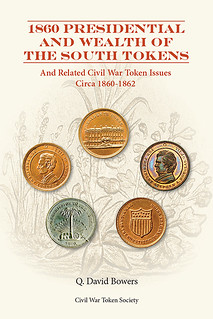 Another week, another Dave Bowers book... This time it's a monograph on Civil War tokens available from the Civil War Token Society.
It's free to members (plus shipping), and a great incentive to join if you haven't already. I've been a member for years and ordered my copy this week.
-Editor
Another week, another Dave Bowers book... This time it's a monograph on Civil War tokens available from the Civil War Token Society.
It's free to members (plus shipping), and a great incentive to join if you haven't already. I've been a member for years and ordered my copy this week.
-Editor
FREE TO CWTS MEMBERS!
Hot off the press, 1860 Presidential And Wealth of the South Tokens by Q. David Bowers. The CWTS has published 1,000 copies and is selling it for $19.95 to non-members. Free to members with a shipping cost of $5 (limited to 1 per member). This is a first-come, first-served offer, so get your request into our book manager or order now. This is the second in a series of three books and will make a wonderful addition to your CWTS numismatic library!
For more information on the Civil War Token Society, see:
http://www.cwtsociety.com/
NEW BOOK: STREATOR'S TRADE TOKENS
Adrián González-Salinas passed along this new book on tokens of Streator, IL by Richard O'Hara, available on Amazon. Thank you! -Editor
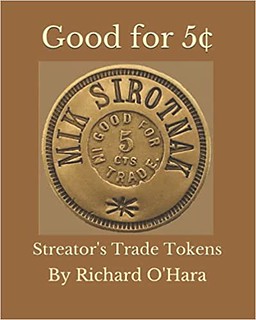 Good for 5¢: Streator's Trade Tokens
Good for 5¢: Streator's Trade Tokens
by Richard O'Hara (Author), Cathy Treschak Higgins (Contributor), David Reed (Contributor)
A random collection of trade token images inspired the creation of this coincidental history of Streator, Illinois. Well illustrated in color, each token takes a place of honor amid other memorabilia and delightful short sketches of the people and places who made Streator such a lively place in the days of its highest peak of commercial enterprise.
Product details
Publisher : Independently published (April 13, 2021)
Language : English
Paperback : 73 pages
ISBN-13 : 979-8737037758
Item Weight : 7.7 ounces
Dimensions : 8 x 0.18 x 10 inches
Here is some text from the book's back cover. -Editor
Trade tokens were colorful "coins" issued by individual saloonkeepers, merchants or institutions. They were returned to customers as change in lieu of genuine pennies, nickels and dimes to induce return visits to sell more groceries, beer, whiskey, fried turtle or other consumables. Towns across America used them frequently from the 1880s on, and many people had pockets full of these mementos of their days and nights.
These particular examples were used in Streator, Illinois and nearby communities during the period 1880 to 1950. This era was a high point in the city's commercial activity, when many small businesses were flourishing, including the downtown watering holes, pool rooms and cigar stores, the ancillary trades and institutions such as Brown's Business College, the Mason's and the Elk's, along with a group of tokens from neighborhood taverns which served working men and their families. Many rare examples are incorporated into this book, even the various bars and "ice cream parlors" in neighboring villages.
"Good for 5¢" is illustrated in full color, with delightfully-detailed images of individual tokens as well as selected portraits and scenic views of these historic days.
For more information, or to order, see:
Good for 5¢: Streator's Trade Tokens Paperback – April 13, 2021
(https://www.amazon.com/Good-5%C2%A2-Streators-Trade-Tokens/dp/B092CLB6YH/ref=sr_1_1)
NEW BOOK: STRIKE IT RICH WITH POCKET CHANGE, 5TH ED.
A new edition of the book Strike It Rich with Pocket Change has been published. Here's the press release. -Editor
Strike It Rich With Pocket Change
- 5th Edition Released
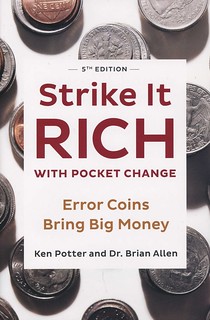 Ken Potter and Dr. Brian Allen have released the 5th edition of their NLG Award Winning book Strike It Rich With Pocket Change – Error Coins Bring Big Money! The authors start out by asking if you ever knowingly spent $100 on a candy bar or $50 on a soft drink? As ludicrous as the concept sounds, the authors suggest that there is no doubt you have unintentionally done this numerous times without even knowing it!
Ken Potter and Dr. Brian Allen have released the 5th edition of their NLG Award Winning book Strike It Rich With Pocket Change – Error Coins Bring Big Money! The authors start out by asking if you ever knowingly spent $100 on a candy bar or $50 on a soft drink? As ludicrous as the concept sounds, the authors suggest that there is no doubt you have unintentionally done this numerous times without even knowing it!
They contend that there are just as many valuable coins in circulation today as there were 50 years ago. As more collectors are drawn to the treasure-hunt appeal of error and variety coins, interest in everyday coins is increasing as people take a closer look at the change in their pocket. This 368-page book is designed to help you find those rarities!
This book helps make sense of phrases like "Doubled Die," "Repunched Mintmark," "Double Edge-Lettering," and "Clashed Dies" for starters.
Readers learn about the different types of errors and varieties and how to spot them using the unique and useful combination of nearly 1000 photos and illustrations.
There is also an all-new chapter on major error types rarely found in pocket change but of general interest to readers who may want to delve into this area of collecting.
It also includes a brand new comprehensive chapter on the rare and very valuable Transitional Errors
such as the 1965 Washington quarter struck on a 90% silver planchet (blank) and others of its ilk that are worth thousands, often tens of thousands of dollars.
Among the coins included in the listings are Lincoln Memorial and Shield cents, Jefferson nickels, Roosevelt dimes, Washington quarters, Kennedy half dollars, Washington quarters (of all types) and all the dollar coins issued since the Eisenhower dollar through the current Presidential and Native American dollars. While the listings focus on the more valuable rare coins, the principles discussed throughout this book can be applied when inspecting any coin for possible errors.
The book received the Extraordinary Merit Award from the Numismatic Literary Guild in 2007. The 2021 5th edition was published by Krause Publications for Penguin Random House who is offering it for $20.00. It can be ordered from Random House as ISBN 9780593328606 at https://www.penguinrandomhouse.com/books.
The book can also be found at Wallmart, Target, Amazon, Barnes & Noble, Books A Million, Bookshop.com, Hudson Booksellers, IndiBound, Powells and some of the mom & pop concerns.
Ken Potter and Dr. Brian Allen can be contacted on the Strike It Rich With Pocket Change Facebook group.
For more information, or to order, see:
Strike It Rich with Pocket Change
(https://www.penguinrandomhouse.com/books/669856/strike-it-rich-with-pocket-change-by-ken-potter-and-dr-brian-allen/)
NEW BOOK: 2022 CANADIAN GOVERNMENT PAPER
The 2022 edition of Charlton's Canadian Government Paper Money book has been published. -Editor
NOW AVAILABLE! Charlton Standard Catalogue of Canadian Government Paper Money Catalogue 2022 – 33rd Edition.
For more information, or to order, see:
2022 CHARLTON STANDARD CATALOGUE CANADIAN GOVERNMENT PAPER MONEY
(https://coinstampsupplies.com/product/2022-charlton-standard-catalogue-canadian-government-paper-money/)
NEW BOOK: MODERN CHINESE PAPER MONEY 2021
CDN Publishing is offering a new edition of the digital book by Patrick Ian Perez (in collaboration with The Banknote Book) on modern Chinese paper money. -Editor
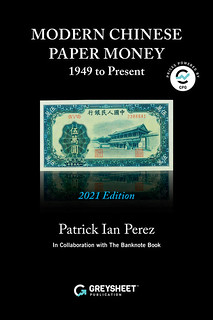 Chinese Bank Notes Cataloged & Priced from 1949 to Present
Chinese Bank Notes Cataloged & Priced from 1949 to Present
This critical book is the only English-language reference of its kind on this popular collectible.
PRODUCT INFORMATION
Your subscription now includes soft-cover or limited edition hardcover edition.
Chinese paper money, in particular the banknotes issued by the People’s Bank of China beginning in 1949, have been among the fastest growing and most popular areas of collectible world paper money.
ll dealers and collectors of world paper money will find this reference highly useful.
- Current Pricing: we cover (7) different grades with pricing for each note, including three levels of Uncirculated as assigned by third-party grading services.
- Hi-rez photographs: to help you quickly and correctly identify these notes and their values.
- Counterfeit detection: a special section on counterfeits, written by Joseph E. Boling, one of the world’s leading experts on authentication of collectible paper money.
Note: only 50 hardcover editions are being printed so do not delay your order.
SUBSCRIPTION DETAILS
This reference book is sold as an annual subscription. You will get the current soft- or hard-cover edition and online viewer access for 12 months after you purchase it. We will make continuous updates and your subscription will include access to the latest edition (via digital viewer on your computer, smartphone or tablet).
For more information, or to order, see:
SUBSCRIBE TO
Modern Chinese Paper Money
(https://www.greysheet.com/publications/modern-chinese-paper-money)
NEWMAN PORTAL: U.S. MINT'S BOLIVIAN COINS
Newman Numismatic Portal intern Garrett Ziss provided the following article based on recently added digital content. Thanks! -Editor
An 1883 letter from Chief of the Secret Service, James J. Brooks, to Superintendent of the Mint,
A. Loudon Snowden, mentions government operatives
and inquiries set afoot.
Even though
it sounds like an excerpt from a Sherlock Holmes novel, this National Archives correspondence,
recently transcribed by the Newman Portal, discusses the possibility of the U.S. Mint striking
coins for the country of Bolivia. The Mint was authorized to produce coins for foreign countries
as specified by an Act of Congress approved on January 29, 1874. However, the correspondence
raises questions about the authenticity of Bolivia’s petition and Brooks requests of Snowden
that no action be taken…as to the preparation of dies for the coining of Bolivian money.
Sixty years later, the outcome was much different when Bolivia was one of more than 20 countries for which the United States produced coins during World War II. Due to the global economic challenges brought on by this War, many countries were unable to make their own coins and the United States helped them maintain their monetary systems. During the War, these foreign coins were produced at cost and did not yield any profit for the Mint. Between July 1, 1942 and June 30, 1944, they produced 30 million Bolivian coins, evenly divided among the denominations of 10, 20, and 50 centavos.
Image: 1942 50 centavos PCGS MS66+RD; Pasadena Collection Registry Set
Image: Annual Report of the Director of the Mint for the Fiscal Year ending June 30, 1944, p. 53
Link to 3 pieces of correspondence regarding Bolivian coins:
https://nnp.wustl.edu/library/book/599780
Link to the Mint Report for the Fiscal Year ending June 30, 1943
https://archive.org/details/annualreportofte1943unit/page/40/mode/2up?q=Bolivia
Link to the Mint Report for the Fiscal Year ending June 30, 1944:
https://archive.org/details/AnnualReportOfTheDirectorOfTheMint1944/page/n55/mode/2up?
VIDEO: DENVER COIN EXPO 2021
These are selections from the David Lisot Video Library that feature news and personalities from the world of coin collecting. David has been attending coin conventions since 1972 and began videotaping in 1985. The Newman Numismatic Portal now lists all David’s videos on their website at:
https://nnp.wustl.edu/library/multimediadetail/522852
Here's one from the recent Denver Coin Expo. -Editor
Denver Coin Expo 2021 Continues to Be Major Numismatic Attraction.
VIDEO: 7:18.
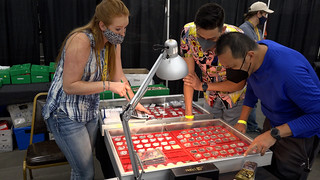 May 6-8, 2021. Neal Hatgi, Manager, Denver Expo, David Lisot, Interviewer, CoinTelevision.com, with Mark Alberici, James Curtis, Judith Kagin, Ashley Sandoval, and Christopher & Matthew Wiley.
May 6-8, 2021. Neal Hatgi, Manager, Denver Expo, David Lisot, Interviewer, CoinTelevision.com, with Mark Alberici, James Curtis, Judith Kagin, Ashley Sandoval, and Christopher & Matthew Wiley.
Denver Expo Show Manager Neal Hatgi shares the challenge of producing the largest coin convention in the Rocky Mountains. Dealers and collectors tell the benefits and desirable aspects of attending the even. Plus you get to see coins, precious metals, paper money and dealer booths.
An excerpt of the video is available for viewing on the Coin Television YouTube Channel at:
https://www.youtube.com/watch?v=PM-Cdpulobs
FIRST EDITION WHITMAN HALF DIME FOLDER
Author and researcher Dave Lange submitted this report about his latest find - a rare 1st edition Whitman Half Dime folder. Congratulations! Nice condition item. -Editor
I'm very excited about purchasing a First Edition Whitman blue folder that was one of only two titles not yet confirmed to exist when my book was published last year. This is Whitman's folder 9005 for half dimes 1794-1873, Lange Number W5¢A1.
Before my book revealed how rare this folder is I would have been able to pick it off on eBay for no more than $20-25. By putting my cards on the table, however, it ended up costing me more than $200 to secure this from someone who knew of its rarity from my article in the December, 2020 issue of The Numismatist. I suppose that was inevitable, but I may yet be able to cherrypick another example down the road. I've found that the best way to smoke out rare items is to publish a book on the subject, and that's why I have to issue annual updates to all of my titles.
For more information on Dave's great book, see:
NEW BOOK: COIN COLLECTING ALBUMS, VOLUME THREE
(https://www.coinbooks.org/v23/esylum_v23n25a03.html)
ROBERT BURNHAM AND COIN COLLECTING
In 2014 Mike Marotta submitted a piece on coins referenced in the classic handbook for astronomers, Burnham's Celestial Handbook. Website visitor Robert Blake, founder of the Escambia Amateur Astronomers Association (EAAA) passed along this related article he published that year in the organization's publication, The Meteor Gallery . Thanks. -Editor
Enclosed are photographs of a coin used as an in illustration in BURNHAM'S CELESTIAL HANDBOOK. The obverse shows Athena while the reverse shows her wise old owl with the crescent moon shown over the owl's shoulder. This is said to be the phase of the moon when the battle of Salamis resulted in the defeat of the Persians---who fielded such a large force, partially naval and partially an army that it was said to drink rivers dry in passage. This was not only among the greatest upsets in history---but, had the first mention in history of a woman commander, an Ionian island queen, Artemisia, taking part in war---ramming and sinking a Persian naval ship
Bob Burnham collected ancient coins. If that was not so---I would not have gotten to know him beyond a nodding acquaintance. He was an overgrown child---very shy about getting to know fellow adults. But, I was hired as a masters student to give the public tours at Lowell Observatory and had a desk in the office also shared by Norm Thomas and Bob Burnham who were the asteroid search program. The one time I tried to engage Bob in conversation beyond just saying, "Hi!"---he acted hostile. But, one day I was asking Norm about adding some ancient coin photos to my program, such as Mars advancing in Roman armor, carrying a spear and shield, Neptune holding a dolphin, Janus, two faced, etc., Bob came right across the room asking, "You collect ancient coins?" I got to know him after that and could bring friends over to meet him to see his home museum---of which he was proud.
Years later, Bob was laid off from Lowell Observatory and was crashing financially in slow motion. I bought several of his coins---and told him that he could buy them back any time at the same price. The rest of his coins went to professional dealers at about 25c on the dollar. Bob never was able to buy back any of the coins. Here is the Athenian tetradrachm. Drachm is ancient/classical Greek. In modern Greek it is drachma with ch pronounced as "k".
To read the complete article, see:
Robert Burnham and Coin Collecting
(http://www.gulfweb.net/rlwalker/astronomy/meteor/201409MeteorGallery.pdf)
To read the earlier E-Sylum article, see:
"HERCULES" COINS IN BURNHAM’S CELESTIAL HANDBOOK
(https://www.coinbooks.org/esylum_v17n51a22.html)
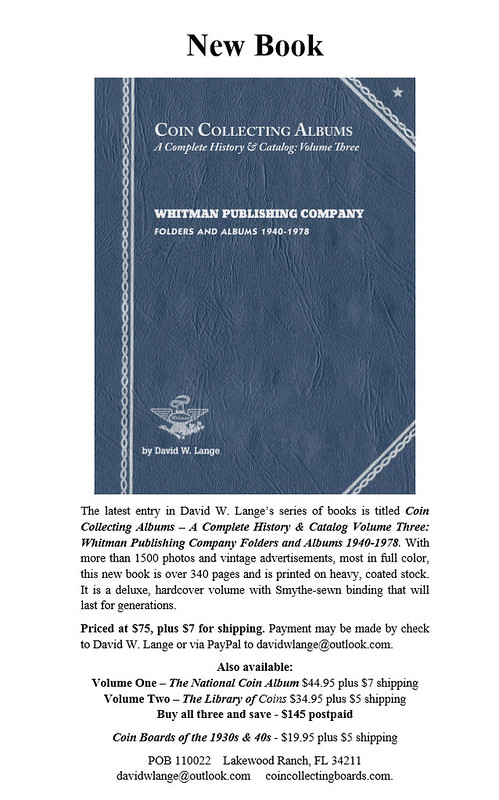
VOCABULARY TERM: EDGE LETTERING, PART 5
Here's the final section from the entry on Edge Lettering and Numbering from from Dick Johnson's Encyclopedia of Coin and Medal Terminology. -Editor
Lettering on Edges
Edge lettering. Wording appearing on the edges – other than names – are the most found edge marking. These include names of the issuer, recipients, sponsors; a wide variety of inscriptions and other data in word form.
Examples of the publisher or sponsor's name include the Albatross Club Medal of 1951 carries the name of the Gruman Aircraft Corporation and its address. The Levi Eshkol Medal of 1967 carried the name of the sponsor, the American Israel Numismatic Association.
One of the most unusual examples of advertising is the 25th Anniversary Medal of Medallic Art Company, in which the medal carried the edge lettering: VANDERBILT 8780, the firm's telephone number! (A year later the firm moved and was issued a new phone number; they obliterated the old number on existing medals, and issued a revised edition with a new number: ELDORADO 3133.)
Slogans have infrequently appeared on edges. An example is a lengthy one on the Pilgrim Medal of Defiance College (in raised letters) which reads: RELIANCE IN SELF, PRIDE IN WORK, COURAGE IN CONSCIENCE, STRENGTH IN EDUCATION, FAITH IN GOD.
One of the most charming edge lettering is found on the Mayflower Medal of 1957. It reads: SIGNING MAYFLOWER COMPACT IN PROVIDENCETOWN (CAPE COD) HARBOR NOVEMBER . 11 . 1620.
Sculptor Joseph A. Colletti (1898-1973) had his name impressed on the edge of every medal made during his lifetime, including such notables as the Dante Medal and one of Albert Schweitzer. Since his death some of the medals have been reissued without his name impressed on the edge (per his written instructions before he died), thus giving rise to two varieties.
Plated medals should have the identity of the base metal stamped on the edge. Such edge lettering would preclude the necessity to make test cuts to identity the under composition. Unfortunately this was seldom done in practice, but modern custom is identifying the base medal on the edge.
Bilingual lettering has occurred on medal edges. Modern Israel has both English and Hebrew inscriptions on medals, particularly state medal issues.
Lettering removed from the edge is usually the name of the recipient (J&J 25:1131) and is called obliterated. The removal of any lettering or figures from the edge is a form of vandalism.
An inscription on the edge of a coin or medal in German is called randschrift.
Seams and solder. Although it is sometimes overlooked, a seam may be observed on the edge of a numismatic or medallic item. As such it would indicate an electrotype or galvano medal in which two separate sides were made separately and then joined together.
Solder marks are infrequently found on the edges where sometimes a loop or hanging device has been removed. This is the evidence that an astute cataloger would state "once mounted."
Trimming marks. Tooling and trimming marks may also be found on edges of medals. All medals not struck in a collar, that is struck by open face dies, must be trimmed of their excess material (flash) after they are struck. Small medals (under 2-inch diameter) – and all unusual shaped medals – are trimmed with a trimming tool and cutter plate. If there is a nick on the cutter plate this will show up as a ridge or striation going across the width of the edge. This is from the shearing action of the punch forcing the medal through the aperture in the cutter plate.
Another example of tooling on large round medals are those that are turned on a lathe (turning off). Their flash is removed by turning on a lathe with a tool cutting off this excess material. The edge is usually squared off with emery cloth. If tool marks are left on without a smoothing off these marks are called annular rings.
Thus we have observed that many kinds of information can be derived from edge marking. Some of it, however, may require reference to numismatic literature to learn of its meaning.
Errors of Edge Lettering
Errors of any lettering on the edge of a coin or medal are called blundered edge lettering. Most of these are of spacing, where letters are missing or overlapping other letters (resulting from misplacing or misapplying where this lettering is applied with a roller die). These would appear for only an individual item. A more series error would be where this is in the lettered collar, where all items struck from that collar would exhibit the blundered lettering.
Where lettering is applied by hand engraving or inscribing, the erroneous lettering would be human error of the craftsman.
To read the complete entry on the Newman Numismatic Portal, see:
Edge Lettering and Numbering
(https://nnp.wustl.edu/library/dictionarydetail/515813)
To read the earlier E-Sylum article, see:
VOCABULARY TERM: EDGE LETTERING, PART 4
(https://www.coinbooks.org/v24/esylum_v24n23a11.html)
1921 BOSTON ANA PHOTO INCLUDES ELMER SEARS
Here's where we typically post entries from the online draft of John Lupia's book of numismatic biographies. The entry for Elmer S. Sears is incomplete but includes a nice photo from the August 21, 1921 issue of the Boston Post picturing a group of spouses from that year's convention of the American Numismatic Association. Lots of big names of the numismatic world, including Sears, Henderson, Bauer, Brenner, Tilden, and Hesslein. Where else could we find photos of their spouses? Check out the hats! -Editor
To read the complete article, see:
SEARS, ELMER SNOW
(http://www.numismaticmall.com/numismaticmall-com/sears-elmer-snow)
EXHIBIT: TREASURE OF CHIANTI
Time for a nice Chianti ... hoard. This article describes a new exhibit of Roman coins found in Chianti, Italy. Bibliophiles note: there is a catalogue of the exhibit. -Editor
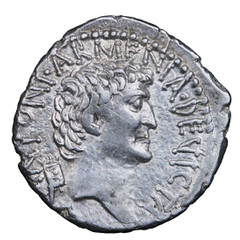 A trove of 194 Roman coins dating from 169 BCE to 27 BCE discovered in 2015 at an archaeological site in Chianti, Italy, are now on public display for the first time in the Santa Maria della Scala Museum in Siena. Friends of Florence funded the restoration and preparation of the silver coins to enable historical, cultural, numismatic, and metallurgic research. This effort yielded Treasure of Chianti: Silver Coinage of the Roman Republic from Cetamura del Chianti, an exhibition that opened May 29 and remains on view through September 2, 2021. The presentation contextualizes the coins within the region’s history and the Republican age.
A trove of 194 Roman coins dating from 169 BCE to 27 BCE discovered in 2015 at an archaeological site in Chianti, Italy, are now on public display for the first time in the Santa Maria della Scala Museum in Siena. Friends of Florence funded the restoration and preparation of the silver coins to enable historical, cultural, numismatic, and metallurgic research. This effort yielded Treasure of Chianti: Silver Coinage of the Roman Republic from Cetamura del Chianti, an exhibition that opened May 29 and remains on view through September 2, 2021. The presentation contextualizes the coins within the region’s history and the Republican age.
The project was organized and led by Florida State University; the Soprintendenza Archeologia, Belle Arti e Paesaggio per le province di Siena, Grosseto, e Arezzo; the Comune di Siena; and the Santa Maria della Scala Museum in collaboration with Friends of Florence and the Studio Arts College International (SACI) in Florence.
Found in a flask buried in what was the ancient Tuscan city of Cetamura where Etruscan fortified settlements were inhabited for centuries, researchers believe that the cache was likely a payment to a veteran soldier who fought in the Battle of Actium (31 BCE). During the pivotal sea battle, Mark Antony and Cleopatra’s fleet was overwhelmed by Octavian’s navy thereby solidifying his command of the Roman Empire as Augustus Caesar. A coin minted in 32 BCE depicts Mark Antony’s profile on one side and the Egyptian queen facing a ship’s prow on the other while others bear images of Octavian.
The discovery was made in 2015 by a team from Florida State University (FSU) directed by Dr. Nancy de Grummond, in collaboration with Ichnos: Archeologia, Ambiente e Sperimentazione from Montelupo Fiorentino. Dr. de Grummond is the M. Lynette Thompson Distinguished Research Professor of Classics at FSU and serves as director of excavations at Cetamura that have been underway since 1973.
The coins underwent micro-excavation and conservation in SACI’s archaeological laboratory under the supervision of Prof. Nòra Marosi. During the Covid-19 pandemic, they were transferred to the Santa Maria della Scala Museum’s laboratories for completion. An exhibition catalogue in English is available for sale at the Museum.
The conservation process revealed new information about the artist-minters’ techniques and experiments, who and what influenced them, and their patrons. The trove was unearthed yards from a large well that for almost 200 years received religious items and grape seeds, providing evidence of the Etruscan and Roman wine-growing tradition in the heart of the Chianti region.
To read the complete article, see:
Coins restored thanks to Friends of Florence support
(https://artdaily.cc/news/136482/Coins-restored-thanks-to-Friends-of-Florence-support#.YMYwoahKhPZ)
VIRTUAL EXHIBITION: COINS OF JESUS
The University of Calgary has opened a virtual exhibit on the coins of Jesus from the Numismatic Collection of Nickle Galleries. -Editor
Coins of Jesus: Money and Religion in the Ancient World
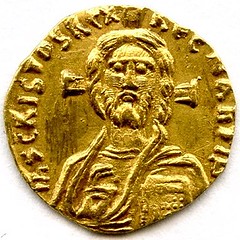 Coins of Jesus is a virtual exhibition that highlights Judeo-Christian coinage in the Numismatics Collection of Nickle Galleries, covering a unique geographic area and a historic period of cultural and ideological diversity. Beginning with Persian Imperial coins and Phoenician shekels, the exhibition presents Jewish, Judeo-Roman, Roman Christian and Byzantine coinage, concluding with Islamic and Medieval money – an intellectually and artistically rewarding journey.
Coins of Jesus is a virtual exhibition that highlights Judeo-Christian coinage in the Numismatics Collection of Nickle Galleries, covering a unique geographic area and a historic period of cultural and ideological diversity. Beginning with Persian Imperial coins and Phoenician shekels, the exhibition presents Jewish, Judeo-Roman, Roman Christian and Byzantine coinage, concluding with Islamic and Medieval money – an intellectually and artistically rewarding journey.
Exhibition curated by Marina Fischer from the Numismatic Collection of Nickle Galleries, University of Calgary
The exhibit encompasses a wide range of history, with sections covering Early Money in the Holy Land, Jewish Coinage, Coins That Jesus Knew, Rome, Judea and Christianity, Christianity in the Byzantine Empire, Money of the Islamic world, and Medieval Europe. Here are a couple pieces that caught my eye. -Editor
For more information, or to view the exhibit, see:
VIRTUAL – Coins of Jesus: Money and Religion in the Ancient World
(https://nickle.ucalgary.ca/exhibition/virtual-coins-of-jesus-money-and-religion-in-the-ancient-world/)
FAROUK 1933 DOUBLE EAGLE BRINGS $18.9 MILLION
The Farouk 1933 Double Eagle set a new record price at auction this week. Here's the press release. -Editor
NEW YORK, 8 June 2021 – This morning in New York, Sotheby’s blockbuster sale Three Treasures – Collected by Stuart Weitzman shattered auction records for the world’s most valuable coin and American philatelic item during an unprecedented auction event. The three-lot live sale totaled $32,039,250.
- Following competitive bidding, the fabled and elusive 1933 Double Eagle Coin, achieved $18.9 million - nearly doubling the world record for a coin - after 3 ½ minutes with three bidders in the room and one on the telephone vying for the only example that may be legally owned by an individual. The sale marks the second time this 1933 Double Eagle coin set a world record as the most valuable coin, having sold at Sotheby’s New York in 2002 for $7.59 million in an auction conducted on behalf of the United States Government following a landmark legal settlement, which for the first and only time, authorized the private ownership of this 1933 Double Eagle alone.
- The sole-surviving example of the legendary British Guiana One-Cent Magenta achieved $8.3 million, retaining its place as the most famous and valuable stamp in the world.
- The Inverted Jenny Plate Block, the most well-known and sought-after American stamp rarity eclipsed its own record for an American philatelic item bringing $4.9 million, and was acquired by noted American collector David Rubenstein. This price also makes the Inverted Jenny Plate Block the second most valuable philatelic item at auction, after the British Guiana One-Cent Magenta.
The three treasures were offered from the collection of the renowned luxury shoe designer, fashion entrepreneur, and philanthropist Stuart Weitzman. A life-long philatelist and numismatist with a deep appreciation for one-of-a-kind objects, Weitzman grew up collecting stamps and coins from an early age in Queens, New York, and he fulfilled his boyhood dream of acquiring the finest stamps and coins beginning with the Double Eagle in 2002 and the British Guiana and Inverted Jenny Plate Block in 2014.
Richard Austin, Sotheby’s Global Head of Books & Manuscripts, commented: Today’s sale marked a historic moment in the history of stamp and coin collecting -- and one that I think will not be surpassed for a long time, if ever. The Stuart Weitzman collection represented the most prized and sought after stamp and coin specimens known to exist, each with deep histories and remarkable stories that have together captured the imaginations of collectors and the general public alike for decades. To offer any one of these pieces at auction would be a milestone in its own right, but to offer them together in this special sale was a once-in-a-lifetime opportunity. The uniqueness of this moment is a testament to Stuart’s passion and dedication to his childhood ambition of acquiring these prized pieces--and we hope this sale inspires other collectors to start their own journey.
Stuart Weitzman added: It has been an honor to be a custodian of these three legendary treasures and it fills me with great joy to have fulfilled a childhood dream of bringing these remarkable pieces together into one collection. I started coin collecting to pass the time in a full leg cast at the age of 12, and later became interested in stamps when my older brother left behind the stamp book he’d started when he went to college. The passion for collecting took root immediately, and today truly marked the culmination of a life’s work. I’m delighted that the proceeds of the sale will help support a number of charitable causes and educational endeavors that are near and dear to me.
All of the seller’s proceeds will benefit charitable ventures, including The Weitzman Family Foundation, which has supported medical research and higher education such as Boston Children’s Hospital and the Stuart Weitzman School of Design at the University of Pennsylvania. Other major Foundation projects include a museum in Madrid, the first of its kind, devoted to Spanish-Judeo history.
The sale naturally generated headlines around the world. Thanks to Arthur Shippee, Leon Saryan and others for forwarding these acccounts. -Editor
To read the complete articles, see:
US Double Eagle gold coin sold for record $18.9m
(https://www.bbc.com/news/world-us-canada-57402432)
US Double Eagle gold coin sells for record-smashing $18.9M
(https://www.aljazeera.com/economy/2021/6/8/us-double-eagle-gold-coin-sells-for-record-smashing-18-9-million)
A Collector’s Rare Treasures Set Records at Sotheby’s
(https://www.nytimes.com/2021/06/08/arts/design/stuart-weitzman-sothebys-stamps-coin-auction.html)
To read the earlier E-Sylum article, see:
THE FAROUK 1933 DOUBLE EAGLE
(https://www.coinbooks.org/v24/esylum_v24n21a24.html)
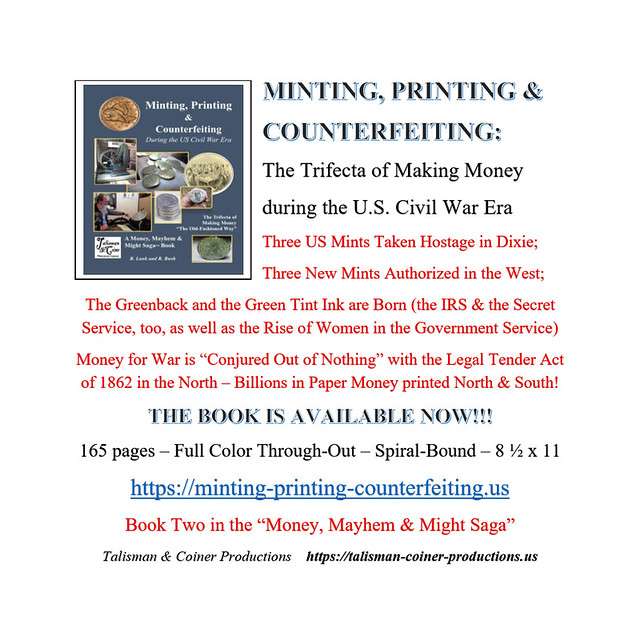
THE FAROUK 1933 DOUBLE EAGLE, PART 3
I ran out of time to prep this article for last week's issue, but here's the next part of the story of the Farouk 1933 Double Eagle, courtesy Sotheby's. Thanks! -Editor
A REMARKABLE CASCADE OF COINCIDENCE(?)
After two and a half years the great gold melt was nearing an end. By the time the task was finished, a purpose-built home for the newly made ingots had been completed: Fort Knox.
On February 6, 1937, the seal was broken on Vault F, Cage 1, which included 1933 Double Eagles; when its contents were poured into the crucibles and rendered into gold bar, the books on the last gold coins produced by the United States were officially closed . . . but coincidentally(?):
MY FIRST RECOLLECTION OF HAVING BOUGHT AND SOLD 1933 DOUBLE EAGLES WAS ABOUT THE BEGINNING OF FEBRUARY 1937.
ISRAEL SWITT, SWORN STATEMENT TO UNITED STATES SECRET SERVICE, MARCH 30, 1944
. . . THIS COIN WAS THE FIRST 1933 DOUBLE EAGLE TO MAKE ITS APPEARANCE AS A COLLECTORS ITEM . . .
COIN DEALER JAMES MACALLISTER TO UNITED STATES SECRET SERVICE, REPORT, APRIL 28, 1944 (REGARDING HIS FEBRUARY 17, 1937 PURCHASE OF A 1933 DOUBLE EAGLE FROM ISRAEL SWITT)
IT HAS BEEN REPORTED THAT A FEW [1933 DOUBLE EAGLES] HAVE ESCAPED THE MELTING POT AND . . . ARE BEING HELD AT A FANCY PRICE.
NUMISMATIC SCRAPBOOK, APRIL, 1937, P. 75
AND THEN IT GOT INTERESTING
The Col. James W. Flanagan collection was to be sold at auction by Stack’s on March 25, 1944. Lot 1681 was highlighted: The excessively rare 1933 Double Eagle . . . the first one that ever came up in any public auction.
A record price was anticipated.
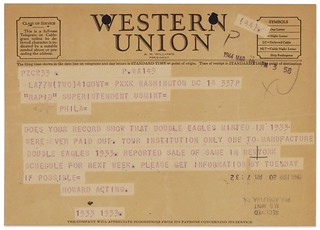 Curious, Ernest Kehr, the stamp and coin editor at the New York Herald Tribune, contacted the United States Mint to verify the accuracy of the catalogue description.20 The inquiry was fielded by Assistant Mint Director Leland Howard who sent a telegraph to the Superintendent of the Philadelphia Mint asking:
Curious, Ernest Kehr, the stamp and coin editor at the New York Herald Tribune, contacted the United States Mint to verify the accuracy of the catalogue description.20 The inquiry was fielded by Assistant Mint Director Leland Howard who sent a telegraph to the Superintendent of the Philadelphia Mint asking: DOES YOUR RECORD SHOW THAT DOUBLE EAGLES MINTED IN 1933 WERE EVER PAID OUT.
The summary response indicated that the official record accounted for every example struck; the United States Treasurer’s office concurred, and Howard’s clipped wire to Kehr concluded: NO DOUBLE EAGLES FOR 1933 RECEIVED IN TREASURER’S OFFICE. CONSEQUENTLY NONE PAID OUT.
Howard took this information to the Chief of the Secret Service, Frank J. Wilson, who got things rolling: Special Agents James Haley and Harry W. Strang arrived at Stack’s the day before the auction. There, to the proprietors’ dismay, the 1933 Double Eagle was seized as being potentially stolen property. The Stacks provided the agents with the name of another owner, Max Berenstein, whose example was also seized. The next day, Strang and Haley confiscated a third example, identified the whereabouts of a fourth, and had accumulated a passel of names and leads that pointed the investigation to Philadelphia.
FILE NUMBER CO-10468
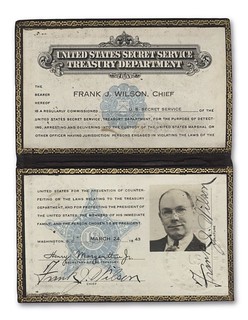 The case number was assigned on March 27, 1944. The prefix,
The case number was assigned on March 27, 1944. The prefix, CO
indicated that the chief was in charge. Frank J. Wilson, considered one of the fathers of modern forensic accounting, began his career in the IRS intelligence unit where he had been at the forefront of putting Al Capone behind bars and tracking down the Lindbergh baby’s kidnapper, and since 1936 had been Chief of the Secret Service. Wilson was, by all accounts, a formidable individual: You could no more shake him nor reflect on his honesty or his sureness of facts than you could melt an iceberg with a blow torch,
wrote Adela Rogers St. John.
Special Agents Strang and George Drescher started working Philadelphia where the investigation unfolded quickly. James G. Macallister, a highly respected coin dealer, informed them he had bought his first 1933 Double Eagle on February 17, 1937 for $500 (he resold it the next day for $1,600), and that prior to that purchase no 1933 Double Eagle had been circulated.
During 1937 Macallister had purchased five 1933 Double Eagles, all from a man called Israel Switt, who gave conflicting stories as to where he had got them. But, in light of Switt’s reputation . . . as a gold coin bootlegger,
Macallister placed little credence in his tales and by year’s end had stopped buying 1933 Double Eagles. Macallister later told the agents that Switt had told him that he and his partner had kept 25 of the 1933 Double Eagles, 14 of which they disposed of.
To read the complete lot description, see:
https://www.sothebys.com/en/buy/auction/2021/three-treasures-collected-by-stuart-weitzman/the-1933-double-eagle
To read the earlier E-Sylum articles, see:
THE FAROUK 1933 DOUBLE EAGLE
(https://www.coinbooks.org/v24/esylum_v24n21a24.html)
THE FAROUK 1933 DOUBLE EAGLE, PART 2
(https://www.coinbooks.org/v24/esylum_v24n22a20.html)
THE BOOK BAZARRE
DNW SHEFFIELD TOKENS AND BADGES
Dix Noonan Webb is offering an interesting collection of local medals and badges in their July sale. Here's the press release. -Editor
The most important collection of Sheffield tokens and badges to come to market is to be included in a sale of Coins, Tokens and Historical Medals on Tuesday, July 6 & Wednesday, July 7, 2021 at international coins, medals, banknotes and jewellery specialists Dix Noonan Webb. Amassed by 68-year-old Sheffielder Tim Hale, who was diagnosed with Parkinson’s a few years ago, the collection of 61 lots, date from the 19th century and cover the city's social history including transport, sport, politics, industry and entertainment. It is expected to fetch £7,000-9,000 with a percentage of the proceeds going to a Parkinson’s charity.
Tim Hale, who has lived in Sheffield for most of his life, commented: …like most Sheffielders (I) am fairly passionate about the place. For most of my adult life…I have collected Sheffield memorabilia, starting when I was in my teens and continuing to this day.
He continued: I still have a fairly substantial collection of Sheffield medals, tokens, badges and other small items of ephemera to part with! In the main, these items have been bought from collectors’ fairs, bric-à-brac shops and through the post from specialist dealers such as Bryan Hennem, Timothy Millett, Sheffield Railwayana Auctions and others along the way. On one occasion I had the opportunity to purchase most of the collection from an old collecting friend and acquiring that group sparked a renewed interest in the genre.
Interesting highlights of the collection an oval silver Sheffield’s Theatre Royal token engraved John Kirkby, Proprietor, which is estimated at £300-£400. The theatre was opened in 1773 but was destroyed by fire in December 1935. The present-day Crucible Theatre is located near the original site.
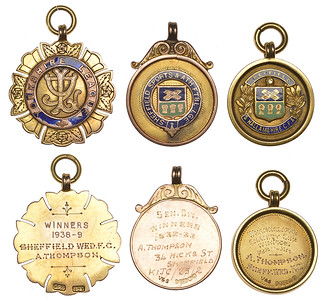 Sporting tokens include a collection from the career of Jack Thompson (b Cramlington, Northumberland, March 1915) who played inside forward for Sheffield Wednesday FC from July 1933 to April 1946, then for Doncaster Rovers, May 1946 to June 1948. These range from Sheffield Sports & Athletic League 1932-33; Sheffield & Hallamshire C[ounty] F[ootball] A[ssociation] 1937-38 and the Yorkshire League 1938-9 (estimate: £200-£260).
Sporting tokens include a collection from the career of Jack Thompson (b Cramlington, Northumberland, March 1915) who played inside forward for Sheffield Wednesday FC from July 1933 to April 1946, then for Doncaster Rovers, May 1946 to June 1948. These range from Sheffield Sports & Athletic League 1932-33; Sheffield & Hallamshire C[ounty] F[ootball] A[ssociation] 1937-38 and the Yorkshire League 1938-9 (estimate: £200-£260).
Among the Military badges is a very fine and rare brass example for the Sheffield & Hallamshire Veterans Guild that is estimated at £60-£80. The Sheffield & Hallamshire Veterans Guild was established in 1892 as a result of public outcry up and down the country at the way soldiers who had served in the Crimea and the Indian Mutiny were treated. Many had taken to begging on the streets and there were calls in Parliament for pensions to be raised. In Sheffield the Guild, known by its full title as the Sheffield and Rotherham Crimean and Indian Veterans' Relief Association, was founded by Sir John Edward Bingham, Bt (1839-1915), a master cutler, head of the firm of Walker & Hall and living in Upper Hallam, and a public subscription was set up to raise funds to supplement soldiers’ annual pensions. Early in its existence it was supporting some 130 pensioners, but by the time of the 1901 annual dinner numbers had dropped to 53. The Guild was wound up after World War I.
A very fine and rare brass historical medals commemorating the Remembrance of the Sheffield Inundation better known as the Great Sheffield Flood is estimated at £60-80. The flood occurred when the Dale Dyke Dam reservoir, constructed in the Loxley Valley by the Sheffield Water Works Co, collapsed on the night of 11 March 1864 during a strong gale, as it was being filled for the first time. As for the physical damage in Sheffield and the nearby areas, 238 people died and some 700 animals drowned; 130 buildings were destroyed and 500 partially damaged; 15 bridges were swept away and six others badly damaged. The claims for damages formed one of the largest insurance claims of the Victorian period – 7,500 claims for loss of life and property which totalled £455,000. The Dale Dyke dam was eventually rebuilt in 1875, but on a smaller scale.
Several medals commemorating Royal Visits will also be offered. A silver medal for the Visit of Queen Victoria to Sheffield to Open the New Town Hall in 1897 is expected to fetch £90-120. Made by the Sheffield Goldsmiths’ Co, it shows the bust of Victoria.
For more information, see:
https://www.dnw.co.uk/
THE MAX BRAIL CANADIAN MEDAL COLLECTION
Craig Whitford writes:
"Max Brail assembled one of the finest collections of U.S. Assay medals outside the U.S. Mint He served on the 1960 Assay Commission), Carnegie Life-saving medals etc. Max was a dear friend of mine and now portions of his collection are being offered at public sale and I thought that your readers might find the sale of his Canadian material interesting.
Marc & Eric from The Canadian Numismatic Company have done a superb job with featuring his collection. A biography of Max is included prior to the offering of his medals."
Thanks. Here are a few medals from the sale. -Editor
Lot 1: 1876 Indian Treaty No. 6 Silver Medal
Indian Treaty No. 6 Silver Medal, 1876; This excessively scarce and historically important Canadian medal represents The Forts Carlton and Pitt Treaties - ?Treaty 6 was signed by Crown representatives and Cree, Assiniboine and Ojibwa leaders on 23 August 1876 at Fort Carlton, Saskatchewan, and on 9 September 1876 at Fort Pitt, Saskatchewan. 120,000 square miles of land were surrendered, comprised of the central portions of the present provinces of Alberta and Saskatchewan. The Indian inhabitants of this area were mainly Cree with some Assiniboine, Saulteaux, and Chipewyan. Enumerated signatories: 118 (Treaties & Surrenders, Nos. 157A-H). AR, 206.0gm (6.62os), 76mm, by J.S. & A.B. Wyon. Queen Victoria crowned & veiled facing left, VICTORIA r., REGINA l.; Rx: Scene of a commissioner of the second rank standing facing right shaking hands with a Native facing left in full dress against a view of tepee's and a rising sun; INDIAN TREATY No. 6 above; 1876 below. edge is unmarked. silver hanger with suspension l
Lot 2: Canadian Confederation Centennial Gold Medals
Medal; Canadian Confederation Centennial Gold Medal Pair, 1867-1967. Commemorating the institution of the Confederation of Canada 1867. AV, 22K, 398.7g (12.819 oz, 1867, edge Hallmarked 22K and "No. 12") & 402.1g (12.929 oz, 1967, edge Hallmarked 22K and "No. 12"); 76mm, by J.S. & A.B, Wyon (1867), struck by John Pinches, Ltd., London. Only 25 Pairs were struck. The "1867" medal depicts a Veiled and crowned Queen Victoria facing left; Rx: Britannia seated facing right with the British Lion at her right and four allegoric figures representing Agriculture, etc before her; The "1967" medal depicts a Canadian Maple Leaf at center. with CONFEDERATION around and the dates 1867/1967 on top; all surrounded by the arms of the 12 provinces; Rx: a modern representation of the four allegoric figures. The "1867" medal: Proof with mirror fields and matte devices, the obverse with scr at 3 o'clock and struck-thru thread? at 10-11 o'clock, the edge with some blemishes. The "1967" medal: Proof with reflective fields and matt
Lot 3: Marquess of Lansdowne Gold Medal
Medal; Lansdowne. Governor General - The Marquess of Lansdowne Gold Medal, 1884. AV, 22K, 104.3 gm (3.35 ozs), 51mm, by J.S. & A.B. Wyon. Cl 104. Conjoined busts f the Marquess. And Marchioness of Lansdowne facing right, inscription around; Rx: Helmeted and supported arms of Lansdowne, inscription around. Unawarded. Edge plain. aEF, reflective fields, hdlg and hairlined, cpl marks on the male's chin; few rbs and edge marks. Housed in a cream velvet lined green leather box (sl wear). Rarely offered. Max Brail Collection.
For more information, or to bid, see:
THE PROMINENCE SALE - IV- Major Event
(https://auctions.canadiancoinsandpapermoney.com/auction/158/the-prominence-sale-iv-major-event)
MORE COLTRANE COLLECTION PART 2 SELECTIONS
Bruce Hagen and Maureen Levine cataloged the Mike Coltrane Collection Part 2 for Heritage, with assistance from Bob Moon and Frank Clark. They submitted this additional selection of highlights. Thanks! -Editor
The Mike Coltrane Collection Part 2 Sale
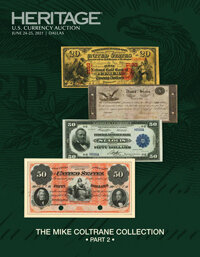 Mike Coltrane enjoyed the interesting challenges presented by large size Federal Reserve Bank Notes. Just as when he began pursuing them decades ago, there are discoveries to be made and rarities to be found. Of the 138 examples cataloged in The Mike Coltrane Collection Part 2 sale, many are from rare districts, are finest known notes, or unpublished variants. They will be sold unreserved by Heritage Auctions on June 24-25, 2021.
Mike Coltrane enjoyed the interesting challenges presented by large size Federal Reserve Bank Notes. Just as when he began pursuing them decades ago, there are discoveries to be made and rarities to be found. Of the 138 examples cataloged in The Mike Coltrane Collection Part 2 sale, many are from rare districts, are finest known notes, or unpublished variants. They will be sold unreserved by Heritage Auctions on June 24-25, 2021.
Federal Reserve Bank Notes (abbreviated FRBN) and Federal Reserve Notes (FRN) were authorized under the same 1913 enactments. The FRBNs were intended as temporary currency to supersede National Bank Notes during the transition to nationwide usage of FRNs, but there was little demand for the first 1915 series. However, notes from the 1918 series filled in for the Silver Certificates during World War I (the backing silver had been sold to Great Britain). Since the vast majority of Silver Certificates printed (such as the Black Eagles
and other 1899 series notes) were $1, $2, and $5 denominations, so were the FRBNs. Presidential portraits were featured on the faces, and the green backs were printed with intricate designs. The $1 and $2 Series of 1918 notes were issued for each of the 12 Federal Reserve Bank districts. All notes have four signatures: a pair of U.S. Federal signatures and a pair of local Federal Reserve Bank officials, generally creating signature combinations within the banks. As a rule, Federal Reserve Bank Notes are much scarcer than Federal Reserve Notes.
Collectors will find an extensive selection whether seeking a popular $2 Battleship
type note, a rare $20 denomination (only five of the 12 districts emitted them), or a very rare variety.
Some highlights include:
Fr. 757 $2 1918 Federal Reserve Bank Note PMG Choice Uncirculated 64 EPQ. - One of the extremely sought-after $2 Battleship
notes, this is a nearly Gem three-digit serial numbered example. Lot 20156.
To read the complete lot description, see:
Fr. 757 $2 1918 Federal Reserve Bank Note PMG Choice Uncirculated 64 EPQ.. ...
(https://currency.ha.com/itm/federal-reserve-bank-notes/fr-757-2-1918-federal-reserve-bank-note-pmg-choice-uncirculated-64-epq/a/3583-20156.s)
Fr. 809a $5 1918 Federal Reserve Bank Note PMG Very Fine 30. – All $5 FRBNs are scarce. This San Francisco example has an unusual face plate compared with other denominations and $5 notes from other districts. Lot 20169.
To read the complete lot description, see:
Fr. 809a $5 1918 Federal Reserve Bank Note PMG Very Fine 30.. ..
(https://currency.ha.com/itm/federal-reserve-bank-notes/fr-809a-5-1918-federal-reserve-bank-note-pmg-very-fine-30/a/3583-20169.s)
Fr. 818 $10 1915 Federal Reserve Bank Note PMG Choice About Uncirculated 58 EPQ. – With great rarity and the finest known example. Only five are in collector’s hands, and this note was last publicly sold in 1991. Lot 20174.
To read the complete lot description, see:
Fr. 818 $10 1915 Federal Reserve Bank Note PMG Choice About Unc 58 EPQ.. ...
(https://currency.ha.com/itm/federal-reserve-bank-notes/fr-818-10-1915-federal-reserve-bank-note-pmg-choice-about-unc-58-epq/a/3583-20174.s)
Fr. 830 $20 1915 Federal Reserve Bank Note PMG Very Fine 20. – All $20 FRBNs are rare, but this Fr. 830 Dallas district is one of the keys in the entire series and one of four known. Lot 20183.
To read the complete lot description, see:
Fr. 830 $20 1915 Federal Reserve Bank Note PMG Very Fine 20.. ...
(https://currency.ha.com/itm/federal-reserve-bank-notes/fr-830-20-1915-federal-reserve-bank-note-pmg-very-fine-20/a/3583-20183.s)
Fr. 831 $50 1918 Federal Reserve Bank Note PMG Choice Extremely Fine 45.
– $50 FRBNs were issued only from St. Louis making this a significant single-Friedberg number type and essential for large size type sets. Lot 20184.
To read the complete lot description, see:
Fr. 831 $50 1918 Federal Reserve Bank Note PMG Choice Extremely Fine 45.. ...
(https://currency.ha.com/itm/federal-reserve-bank-notes/fr-831-50-1918-federal-reserve-bank-note-pmg-choice-extremely-fine-45/a/3583-20184.s)
All lots are currently on Heritage Auctions preview at HA.com/3583. The sale will be held in Dallas with Session 1 (floor) on June 24 and Session 2 (HERITAGELive, Internet, Fax, and Mail only) on June 25. Lot viewing will be available by appointment only at Heritage’s Office in Dallas (June 21-25, 2021); contact Jose Berumen at JBerumen@ha.com or 214-409-1299.
To read the earlier E-Sylum article, see:
COLTRANE COLLECTION PART 2 SELECTIONS
(https://www.coinbooks.org/v24/esylum_v24n23a15.html)
NUMISMATIC NUGGETS: JUNE 13, 2021
Here's a selection of interesting or unusual items I came across in the marketplace this week. Tell us what you think of some of these. -Editor
1794 Suffolk Bury Penny Conder Token MS-65+ PCGS (BN)
A nice Conder token from Golden Gate Auctions in California. -Editor
To read the complete lot description, see:
1794 Suffolk Bury Penny Conder Token MS-65+ PCGS (BN)
(https://www.liveauctioneers.com/item/105479914_1794-suffolk-bury-penny-conder-token-ms-65-pcgs-bn)
Hard Times token LOW 129 R3 HT169 NGC AU50. Roxbury Coaches New Line 1837 (350-400).
A nice plain early transportation piece from Steve Hayden's eBay offerings. -Editor
To read the complete lot description, see:
1837 Boston Massachusetts Hard Times Transportation Token Roxbury Coaches NGC
(https://www.ebay.com/itm/203482307520?hash=item2f607d9bc0:g:V8EAAOSw96VguTP4)
Art Nouveau NUDES Angel Carnegie Hero 1931 Award Bronze Medal by LOUIS DEJEAN!
I have one of these. Found on eBay. Nice medal. -Editor
To read the complete lot description, see:
Art Nouveau NUDES Angel Carnegie Hero 1931 Award Bronze Medal by LOUIS DEJEAN!
(https://www.ebay.com/itm/304030549734)
THE EARLY COINAGE OF LEBANON
Stack's Bowers Senior Numismatist and Cataloger Jeremy Bostwick published a blog article on the early coinage of Lebanon. -Editor
Following World War I and the demise of the once vast and powerful Ottoman Empire, various parts of the realm were partitioned off, including the land that makes up present-day Lebanon. In this case, France held a mandate officially meant to foster future states, although such mandates often entered the sphere of pseudo-colonialism. Not surprisingly, the early coinage of Lebanon—beginning in 1924—featured a strong French flair owing mostly to their manufacture at the mint in Paris. One of the more indigenous aspects of the coinage is the Lebanese cedar, an iconic arboreal image often rather prominently displayed. Our June Collectors Choice Online (CCO) World auction presents a diverse selection of these early issues. Also offered are some interesting, cruder, locally produced denominations from during World War II, with each standing as one of the finer—or even finest—seen for its type
See the complete article online for more, but here are a couple pieces that caught my eye. -Editor
To read the complete article, see:
The Early Coinage of Lebanon—An Array of High Grade Offerings
(https://www.stacksbowers.com/News/Pages/Blogs.aspx?ArticleID=coins-from-lebanon-stacks-bowers-galleries-online-world-coin-auction)
1944 STEEL CENT OFFERED
Here's a Heritage press release on a popular transitional error coin - the 1944 steel cent. The planchets were in use at the Philadelphia Mint during 1944 to strike two franc pieces for Belgium. -Editor
Whenever a 1943 Bronze Cent or a 1944 Steel Cent are sold, headlines are made! Heritage Auctions is honored to offer a rare 1944 Steel Cent error in the June US Coin Auction 1331. The 1943 and 1944 error Cents are so engrained in the public consciousness as being rare that Heritage receives inquiries literally every day from hopefuls who are wishing that they found one of the rare versions, but very, very few people actually have the "right" coin.
These transitional error coins occurred when the US Mint was supposed to resume the use of the normal bronze planchets in 1944. The Mint had temporarily used zinc/steel planchets in 1943 to save copper for the war effort and was switching back to the regular pre-War composition the following year as things began to normalize. However, a few accidents secretly escaped the Mint that were unintentionally struck on the wrong planchets--the previous year's steel version!
Approximately 25 to 30 of these dramatic error coins are believed to exist in all grades, although there are not actually that many certified. NGC has certified only four 1944 steel cents, all in AU grades. PCGS has graded ten examples, two in AU and eight in Mint State, but none finer than MS64. We can locate only a single price realized at the MS64 level, a PCGS CAC example that brought $158,625 as lot 4411 in an August 2013 Stack's Bowers sale. This attractive example is graded MS64 by PCGS.
This six-figure error will be a true coup for whatever lucky collector ends up purchasing it! See this cool coin here:
https://coins.ha.com/itm/lincoln-cents/1944-1c-struck-on-a-zinc-coated-steel-planchet-ms64-pcgs/a/1331-3043.s?ic4=GalleryView-Thumbnail-071515
BRITISH VIRGIN ISLANDS MORGAN-PEACE DESIGN
Other mints are capitalizing on the centennial anniversaries of the last Morgan dollar and first Peace Dollar. Here's an article by Michael Alexander on the World Mint News Blog about the Pobjoy Mint's piece for the British Virgin Islands. I recall seeing a report that these were already sold out. -Editor
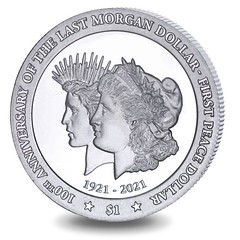 The government of the British Virgin Islands has issued (20th May) new bullion-quality silver one-ounce coins, cupro-nickel Brilliant Uncirculated, and gold half-gram Proof coins which feature two of the coin collecting world’s most popular and historic designs ever to be included on American coinage — namely the Morgan and Peace dollar designs. On the occasion of the centenary anniversary, which saw the U.S. Mint transition from the Morgan motif to that of the Peace design in 1921, it was the year that saw both designs dated the same year.
The government of the British Virgin Islands has issued (20th May) new bullion-quality silver one-ounce coins, cupro-nickel Brilliant Uncirculated, and gold half-gram Proof coins which feature two of the coin collecting world’s most popular and historic designs ever to be included on American coinage — namely the Morgan and Peace dollar designs. On the occasion of the centenary anniversary, which saw the U.S. Mint transition from the Morgan motif to that of the Peace design in 1921, it was the year that saw both designs dated the same year.
In 1876, the U.S. Mint director began efforts to redesign the U.S. silver dollar. He contacted the deputy master of the Royal Mint in London, looking for a die-sinker: The task of engraving dies used to stamp designs on coins or medals, who would be willing to take the position of assistant engraver at the U.S. Mint. George T Morgan (1845–1925) was highly recommended and he began working for the U.S. Mint. Morgan, who was born in Birmingham, England, soon emigrated to the United States and arrived at the U.S. Mint in Philadelphia where he took up the position as a die engraver. The Morgan dollar, which is considered one of the coin world’s most widely collected American coins, was first minted annually from 1878 to 1904 and then again in 1921. Therefore, the coin was named after its designer. The obverse depicts an allegorical interpretation in profile portrait representing Liberty.
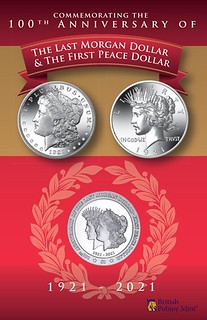 The Peace dollar owes its existence to the Era of Peace, which was ushered in after the devastation of what was then termed the
The Peace dollar owes its existence to the Era of Peace, which was ushered in after the devastation of what was then termed the Great War,
or the war to end all wars.
Minted from 1921 to 1928 and then again in 1934 and 1935, it was designed by Anthony de Francisci (1887–1964), an Italian-American sculptor as a result of a competition to find designs representing Peace. The design depicted the head of the Goddess of Liberty in profile, a crown of rays adorning her head. It was later learned that de Francisci had modelled the profile after his wife Theresa, who sat for him on several occasions.
The coins are produced by the Pobjoy Mint at their facilities in Surrey, England, on behalf of the treasury of the British Virgin Islands. The design on this brand-new coin features the two profile images of the portrait representing Liberty and the portrait of the Goddess of Liberty representing Peace — both facing to the left and as they appeared on the original coins. The dates 1921 – 2021 are shown beneath the two busts. The inscription 100TH ANNIVERSARY OF THE LAST MORGAN DOLLAR – FIRST PEACE DOLLAR is placed around the primary design with the denomination of $1 placed below.
To read the complete article, see:
Pobjoy Mint — British Virgin Islands: New silver bullion coin features historic Morgan and Peace dollar designs for centenary anniversary
(https://world.mintnewsblog.com/2021/05/pobjoy-mint-british-virgin-islands-new-silver-bullion-coin-features-historic-morgan-and-peace-dollar-designs-for-centenary-anniversary/)
1801 THOMAS JEFFERSON SILVER INAUGURAL MEDAL
Here's a Heritage press release about a great medal - a 1801 Thomas Jefferson Inaugural Medal in silver. -Editor
Heritage Auctions' June US Coin Sale 1331 brings us a rare opportunity to own a piece of history that combines scarcity, beauty, and a close connection to early American independence.
From the same collection as the two fabulous Libertas Americana medals comes an 1801 Thomas Jefferson Inaugural Medal in silver, one of only about a dozen pieces known to exist in any grade! The 1801 Jefferson Inaugural medal was struck in both silver and white metal to commemorate the 25th anniversary of the signing of the Declaration of Independence and Jefferson's ascent to the office of the presidency. Jefferson was, of course, the leading author of that document on July 4, 1776, and he passed away 50 years to the day it was signed.
Catalogued by R.W. Julian as PR-2, these 1801 Jefferson medals were produced at the behest of Philadelphia Mint Chief Coiner Henry Voigt, a staunch supporter of Jefferson, and engraved by then-newcomer John Reich of Germany. It is believed that about two dozen pieces exist in silver and white metal combined, with half of those represented by this more exotic metal (silver.)
In the world of medals and exonumia collecting, the silver versions are almost always more valuable than either bronze or white metal due to their typically lower mintages. These pieces also confer the benefits of the beautiful toning that can sometimes form on the surfaces after years of careful storage. That is certainly true of this lovely medal! This early American rarity features deep gunmetal-blue toning over the entire obverse and much of the reverse, which shows added accents of violet and gold patina.
Reich's masterful portrait of Jefferson and his rendering of Minerva, representative of Liberty, holding the Declaration of Independence are fully struck up and free of friction. The medal was likely wiped lightly long ago, with minor hairlines beneath the lovely overlay. They pose no distraction at all. Simply put, the importance and historic nature of this remarkable medallic offering cannot be overstated. We strongly encourage interested parties to bid accordingly.
This medal would have cross-category appeal to Historical/Americana bidders. See more views of this wonderful piece of history here:
https://coins.ha.com/itm/u.s.-mint-medals/1801-thomas-jefferson-inaugural-medal-silver-ms62-ngc-eidlitz-1-julian-pr-2-dewitt-tj-1800-1/a/1331-3264.s
THE BOOK BAZARRE
PLATES USED TO OVERPRINT 1929 NATIONALS
It's a very specialized topic, but this Numismatic News article by Peter Huntoon is an interesting look into the manufacturing of National Bank Notes. Here's an excerpt, but see the complete article online. -Editor
The purpose of this article is to provide a procedure that will allow you to identify the manufacturer of the overprinting plate used to print the bank information on any Series of 1929 national bank note. This procedure is far easier to use and more fool proof than previous versions circulated by James Simek or published in Huntoon and Simek (2014).
Series of 1929 Overprinting Plates
Three different manufacturers made the typographic overprinting plates that applied the black bank information to Series of 1929 national bank notes.
Most of the overprinting plates were made by Barnhart Brothers & Spindler, a Chicago firm that was awarded a contract by the Bureau of Engraving and Printing to supply all the overprinting plates. The BBS plates were called logotypes, which were cast using a hard metal alloy.
BBS couldn’t keep up with the demand for plates during the startup of the series, so the Bureau of Engraving and Printing contracted with the Government Printing Office to make interim electrotype plates using forms prepared at the Bureau. The first GPO stopgap overprinting plates were finished August 26, 1929. The 1,375th required to meet the mid-October deliveries of notes to the Comptroller arrived October 16th (BEP, Aug-Nov, 1929). A handful of GPO plates were made from then into early 1930 to cover expedited orders received from the Comptroller of the Currency bringing the grand total of GPO plates to 1,380 (Hall, 1930, p. 22).
The GPO plates were used only for the first printing for the affected banks. The reason was that electrotype plates were soft so in prolonged use, the nickel-faced, lead alloy-backed type would wear poorly and deform under the demanding conditions attending use on the BEP overprinting presses. In contrast, the BBS logotypes were four times harder.
The GPO plates were succeeded by BBS logotypes in due course as deliveries of the logotypes caught up. The notes printed from the BBS plates had the same bank signatures, but the layouts differ. The earlier notes in these pairs often have larger signatures so the variety is popularly known as the large-signature variety.
The quality of the GPO overprints as judged by the crispness of the images was superior to that of the BBS logotypes.
To read the complete article, see:
Simplified Procedure for Identifying the Manufacturers of Plates Used to Overprint 1929 Nationals
(https://www.numismaticnews.net/collecting-101/simplified-procedure-for-identifying-the-manufacturers-of-plates-used-to-overprint-1929-nationals)
MONEY DESIGNS AND SOCIAL MOVEMENTS
Historian Peter Y.W. Lee published an article in Smithsonian magazine connecting paper money designs to social movements throughout U.S. history. Thanks to David Gladfelter for passing this along. -Editor
Momentum for the Tubman Twenty
comes at a time when Americans are reexamining foundational values of equality and democracy. President Joe Biden’s inaugural address urged national unity to heal political and social rifts, and his push to get the project—in the works since 2015 to replace Andrew Jackson’s portrait with Harriet Tubman’s on the $20 bill—back on track supposedly helps do just that.
This is not the first attempt to use currency to forge a national identity by commemorating a shared heritage. An earlier experiment 125 years ago attempted to do the same. But—spoiler alert—it failed in every sense.
The United States introduced silver certificates in 1878, at a time when the meaning of money was up for grabs. In the late 1890s, the nation was in the early process of transforming from a rural agrarian society into an industrialized, urbanized empire teeming with immigrants. But growing pains brought an identity crisis; new peoples, cultures, technologies, and work habits challenged the status quo, exposing political, social, and class conflicts that came to a head in the 1896 presidential election.
The free silver movement—to allow for unfettered silver coinage alongside the gold standard—reflected these divides. Proponents, many of whom were Western farmers and miners, believed free silver would expand the money supply for the poor. But gold supporters—often situated in Eastern metropolises—saw free silver as an attack on the country’s financial lifeblood, their own fortunes, and their class standing as sophisticated, urbane elites. The Secretary of the Treasury at the time, John G. Carlisle, supported gold, but recognized silver as poor man’s money
and, with enthusiastic support from the Chief of the Bureau of Engraving, Claude M. Johnson, authorized a prestigious, artistic, educational
series of silver certificates as a form of celebratory nationalism.
The Bureau of Engraving and Printing commissioned publicly acclaimed muralists William H. Low, Edwin Blashfield, and Walter Shirlaw, who had decorated government buildings and represented American art in international expos, to design the denominations. It certainly would, from an artistic standpoint, be commencing at the very root to put a work of art in the hands of every man who buys a loaf of bread,
Low commented in 1893.
Low glorified a collective American past by portraying the Constitution as a civics lesson for the nation’s children. In his $1 certificate, entitled History Instructing Youth, Low depicted the Washington, D.C., skyline behind History,
personified as a goddess, who is pointing at the Constitution to enlighten a boy. The reverse features George and Martha Washington. It’s a reflection of the time’s child savers movement—whereby white, middle-class philanthropists assimilated immigrant and lower-class children into productive workers and good citizens.
The theme of youth and citizenship reflected the free silver position. Coin’s Financial School, a popular booklet starring a young financier named Coin, differentiated democratic silver from aristocratic gold: One was the money of the people—the other, of the rich.
In its pages, gold bugs like banker Lyman Gage, who detested silver and would succeed Carlisle as Secretary of the Treasury, were won over by Coin’s persuasive messaging and by the youth who delivered it.
While the $1 certificate glorified the past, the $2 and $5 certificates highlighted technological and national progress. Edwin Blashfield’s Science Presenting Steam and Electricity to Commerce and Manufacture was a paean to industrialization. Steam
and Electricity
are children who join the adults, Commerce
and Manufacture.
Their proud fathers, inventors Robert Fulton (the steamboat) and Samuel Morse (the telegraph), preside from the reverse. The $5 certificate, Walter Shirlaw’s America,
celebrated Americanism’s triumphs abroad. The figure of America
wields Thomas Edison’s lightbulb to (en)lighten the world, and on the reverse, generals Ulysses Grant and Philip Sheridan watch the emergence of empire.
To read the complete article, see:
The U.S. Government’s Failed Attempt to Forge Unity Through Currency
(https://www.smithsonianmag.com/history/free-silver-movements-failed-attempt-forge-unity-through-currency-180977966/)
PHILIPPINE CENTENNIAL COMMEMORATIVE NOTE
A commemorative banknote has been produced for the Philippine Centennial. -Editor
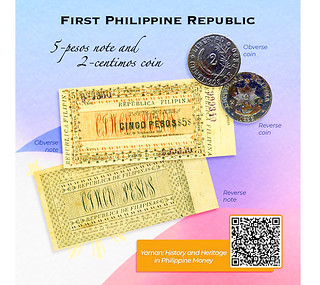 The Bangko Sentral ng Pilipinas is featuring a numismatic and art collection to celebrate the country’s 123rd Independence Day on June 12.
The Bangko Sentral ng Pilipinas is featuring a numismatic and art collection to celebrate the country’s 123rd Independence Day on June 12.
On its Facebook page, BSP features the 100,000-piso Philippine Centennial Commemorative Banknote, the first Philippine Republic cinco-pesos note, and dos-centimos coin.
The commemorative banknote, paper money, and coins are showcased in the agency’s latest publication, Yaman: History and Heritage in Philippine Money.
The 100,000-piso Philippine Centennial Commemorative Banknote honors historic victories during the Philippine Revolution where its obverse side shows the Sigaw ng Himagsikan
on Aug. 24, 1896, while its reverse side showcases a scene of the Proclamation of the Philippine Independence in Kawit, Cavite on June 12, 1898.
Only 1,000 pieces of these were printed. With dimensions similar to a legal-size bond paper or 8.5 x 14 inches, it is, so far, the biggest legal tender note issued by the Bangko Sentral ng Pilipinas, both in terms of face value and size,
the BSP said.
The cinco-pesos note is about the same size as the present-day banknote, while the dos-centimos coin is near the size of the current five-piso coin.
In the last weeks of 1989, the Malolos Congress approved the issuance of paper banknotes. Pedro Paterno, Telesforo Chuidian, and Mariano Limjap signed the notes individually to avoid counterfeiting.
The issuance of coins and paper money was a way for the government to project its identity as a sovereign authority,
the BSP said in another Facebook post.
To read the complete article, see:
BSP features numismatic collection for 123rd Independence Day rites
(https://manilastandard.net/mobile/article/356954)
In case you missed it, see the earlier article for information on the new book on the history of money in the Philippines. -Editor
To read the earlier E-Sylum article, see:
NEW BOOK: YAMAN: PHILIPPINE MONEY
(https://www.coinbooks.org/v24/esylum_v24n21a05.html)
THE NEW DETECTORISTS
A recent New York Times article highlights a new generation of metal detectorists. -Editor
Nikoline Bohr, 32, who is a member of the Ring Finders network, with her metal detector at a construction site on Nantucket Island in Massachusetts.Credit...
People have been metal detecting since 1881, when Alexander Graham Bell invented a device to find the bullet lodged in President James Garfield.
But it took several more decades for recreational metal detectors — devices that resemble sort of a skillet on the end of a pole,
as one newspaper put it in 1967 — to develop a serious cult following.
Now, that cult following is growing. Detector makers are reporting record sales. According to an annual report from one brand, Minelab, in 2020 the company sold 30 percent more detectors than the previous year, which had climbed 18 percent the year before that.
And we are in a bit of a detectorist media moment. New York magazine is making listicles of the best metal detector models. Drew Barrymore is giving them away on her show. The teenage sketch comedian Parker James is wielding one before his six million TikTok followers. In England, Carey Mulligan is making it mainstream; on Nantucket, millennials are making it fashion; and in the gaming industry, a romantic thriller-meets-metal detecting video game will be released this summer.
While some longtime detectorists relish the hobby’s solitary nature, others have been hungry for more attention. For the past eight years, Michael Bennett, known as Nugget Noggin,
a 27-year-old gold-prospecting enthusiast in Charlotte, N.C., has been posting YouTube videos of his finds, which include Mercury dimes, Morgan dollars and Civil War-era musket balls and belt buckles.
At first, no one paid much attention. Today, detectorist content creation is his full-time job.
It was kind of tough when I first started,
Mr. Bennett said. When people thought of metal detecting they thought of the old guy on the beach. Now, it’s not just men — women are doing it too, and a lot of people my age.
Detectorist YouTubers and television shows in recent years have helped draw a new audience to the pastime. But more recently, a propelling force of its rising popularity is — you guessed it — the pandemic. In Saunderstown, R.I. this past fall, 150 enthusiasts paid $125 each to hunt on a local farm that was seeded by the event organizers with 1,500 antique coins valued at some $6,000. It didn’t matter that the coins were planted; social distancing was built in.
Ryson Zettlemoyer, a 36-year-old gem cutter, handyman and detectorist operating near Eureka, Calif., agrees that the pastime is growing in popularity and it’s no wonder, he said. According to Mr. Zettlemoyer, there are thousands of documented buried major treasures
in the United States yet to be found, just from the 1800s alone. His Ring Finder profile notes that he charges a commission on caches and hoards
of gold treasure.
In the 1930s, thousands of banks closed their doors, while at the same time, the federal government passed an act to seize citizens’ gold. A lot of people who had gold buried it — and a lot of that stuff is still out there,
Mr. Zettlemoyer said.
For one recent commission, he searched for two days and located a Mason jar buried a foot deep containing several gold bullions, and two one-ounce gold bars.
That’s a family’s inheritance,
he said. So they call people like me to come out and find it.
To read the complete article, see:
The New Detectorists
(https://www.nytimes.com/2021/05/31/style/metal-detectorists-ring-finders.html)
CERTIFIED COLLECTIBLES GROUP HIGHLIGHTED
Recently, we've discussed the white-hot market for grading sports cards. An article in the Tampa Bay Times interviews Max Spiegel of Certified Collectibles Group. -Editor
Since February, we’ve received hundreds of thousands of sports cards,
said Certified Collectibles Group president Max Spiegel. That’s shocking, considering it normally takes time to build a grading service. That just shows how hot that market is.
Hot doesn’t begin to describe it. The sports card boom of 2021 bears little resemblance to the early ’90s, when Boomers shelled out big bucks for the Mantle and Mays rookies their moms threw out in the ‘60s; and a glut of new products flooded (and ultimately devalued) the market.
Today’s sports card industry has more in common with the art market, as ultra-rare, ultra-high-end cards command small fortunes at auction. In August, a 1-of-1 Mike Trout autographed rookie card sold for a record $3.9 million. Last week, an autographed Tom Brady rookie sold for $3.1 million, a record for a football card. The market’s gotten so heated that Target recently stopped selling trading cards to discourage shoppers from fighting for packs.
Pam Mitchell looks closely at a German Thaler coin while working in the grading room at Certified Collectibles Group's headquarters in Sarasota on June 8. [ MARTHA ASENCIO-RHINE | Times ]
Over the years, the Certified Collectibles Group has operated quietly, courting little public attention, given the value of the items that pass through its Lakewood Ranch headquarters. Spiegel said the private company has about $100 million in annual revenue, with dozens of employees in London, Munich, Shanghai and Hong Kong.
But the sports card market has forced the company to open up a bit. Like other industries, the grading business is facing a hiring shortage, as companies struggle to keep up with demand. Certified Collectibles Group is looking to add about 100 employees to its staff of 400 in Sarasota, from graders to accountants to mail clerks. It’s dangling a $2,500 bonus for those who sign on and stay for at least six months.
With graders, because it’s a specialized position, and because there’s so much demand, we will hire anybody who’s qualified,
Spiegel said. Once you find them, you don’t want to lose them.
Especially the longer the sports card market stays this hot.
We always knew that it would rebound,
Spiegel said. Where it’s at today, I don’t think anybody could have predicted. This is just really unlike anything we’ve ever seen before in any of our collectible categories.
To read the complete article, see:
As sports card market goes wild, Tampa Bay card grading company cashes in
(https://www.tampabay.com/news/business/2021/06/09/as-sports-card-market-goes-wild-tampa-bay-card-grading-company-cashes-in/)
To read earlier E-Sylum articles, see:
FEIGENBAUM: COINS ECLIPSED BY SPORTS CARDS
(https://www.coinbooks.org/v23/esylum_v23n49a12.html)
BECKETT SUSPENDS MOST GRADING SERVICES
(https://www.coinbooks.org/v24/esylum_v24n23a31.html)
LOOSE CHANGE: JUNE 13, 2021
Here are some additional items in the media this week that may be of interest. -Editor
This article is an overview of obsolete banknotes. Found via News & Notes from the Society of Paper Money Collectors (Volume VI, Number 51 June 8, 2021). -Editor
The rise and fall in the price of Bitcoin based on Elon Musk’s tweets is a reminder that most people view the private digital currency more as an investment than usable money. But there was a time in the United States when private money was a very viable option. Before the Civil War and the printing of the first greenbacks, historian Stephen Mihm writes, hundreds of local banks issued thousands of different kinds of currency in a bewildering variety of denominations and designs,
which became the de facto currency of the country.
Before the American Revolution, economic historian Howard Bodenhorn explains, Britain didn’t send enough small-denomination copper and silver coins to the colonies to meet local needs. So colonial loan offices and land banks issued bills of credit for under 20 shillings. Minting of coins remained limited well into the nineteenth century, and local commercial banks picked up the slack. They took in gold and gave out bank notes in return, including some in very small denominations.
Bodenhorn writes that people used this paper currency in everyday transactions. But it couldn’t circulate too far from the issuing bank, where the notes could be redeemed. Merchants located at a distance often only accepted them at a discount or wouldn’t take them at all. To make the notes more useful, some country banks made deals to get their counterparts in nearby cities to redeem them.
Buyers and sellers had to be careful about the bills they used, Bodenhorn writes. If a bank went belly-up, its currency would become unredeemable and worthless. So merchants and consumers often used brokers, who monitored the quality of banknotes.
To read the complete article, see:
Banks’ Own Private Currencies in 19th-Century America
(https://daily.jstor.org/banks-own-private-currencies-in-19th-century-america/)
The Federal Reserve is continuing to review options for issuing a crypto currency. -Editor
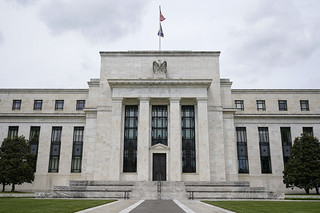 The Federal Reserve is taking what may be the first significant step toward launching its own virtual currency, a move that could shake up banks, give millions of low-income Americans access to the financial system and fortify the dollar's status as the world’s reserve currency.
The Federal Reserve is taking what may be the first significant step toward launching its own virtual currency, a move that could shake up banks, give millions of low-income Americans access to the financial system and fortify the dollar's status as the world’s reserve currency.
The idea of creating a fully digital version of the U.S. dollar, which was unthinkable just a few years ago, has gained bipartisan interest from lawmakers as diverse as Sens. Elizabeth Warren (D-Mass.) and John Kennedy (R-La.) because of its potential benefits for consumers who don’t have bank accounts. But it’s also sparking strong pushback from those with the most to lose: banks.
The explosive rise of private cryptocurrencies in recent years motivated the Fed to start considering a digital dollar to be used alongside the traditional paper currency. The biggest driver of concern was a Facebook-led effort, launched in 2019, to build a global payments network using crypto technology. Though that effort is now much narrower, it demonstrated how the private sector could, in theory, create a massive currency system outside government control.
Now, central banks around the world have begun exploring the idea of issuing their own digital currencies — a fiat version of a cryptocurrency that would operate more like physical cash — that would have some of the same technological benefits as other cryptocurrencies.
To read the complete article, see:
Fed explores ‘once in a century’ bid to remake the U.S. dollar
(https://www.politico.com/news/2021/06/12/fed-remake-us-dollar-493548)

